- RANGEFINDERS
- VIEWFINDERS
- TYPES OF LENSES
- FILTERS
- DARKROOM EQUIPMENT
- PROJECTORS & VIEWERS
- TRIPODS
- MISCELLANEOUS
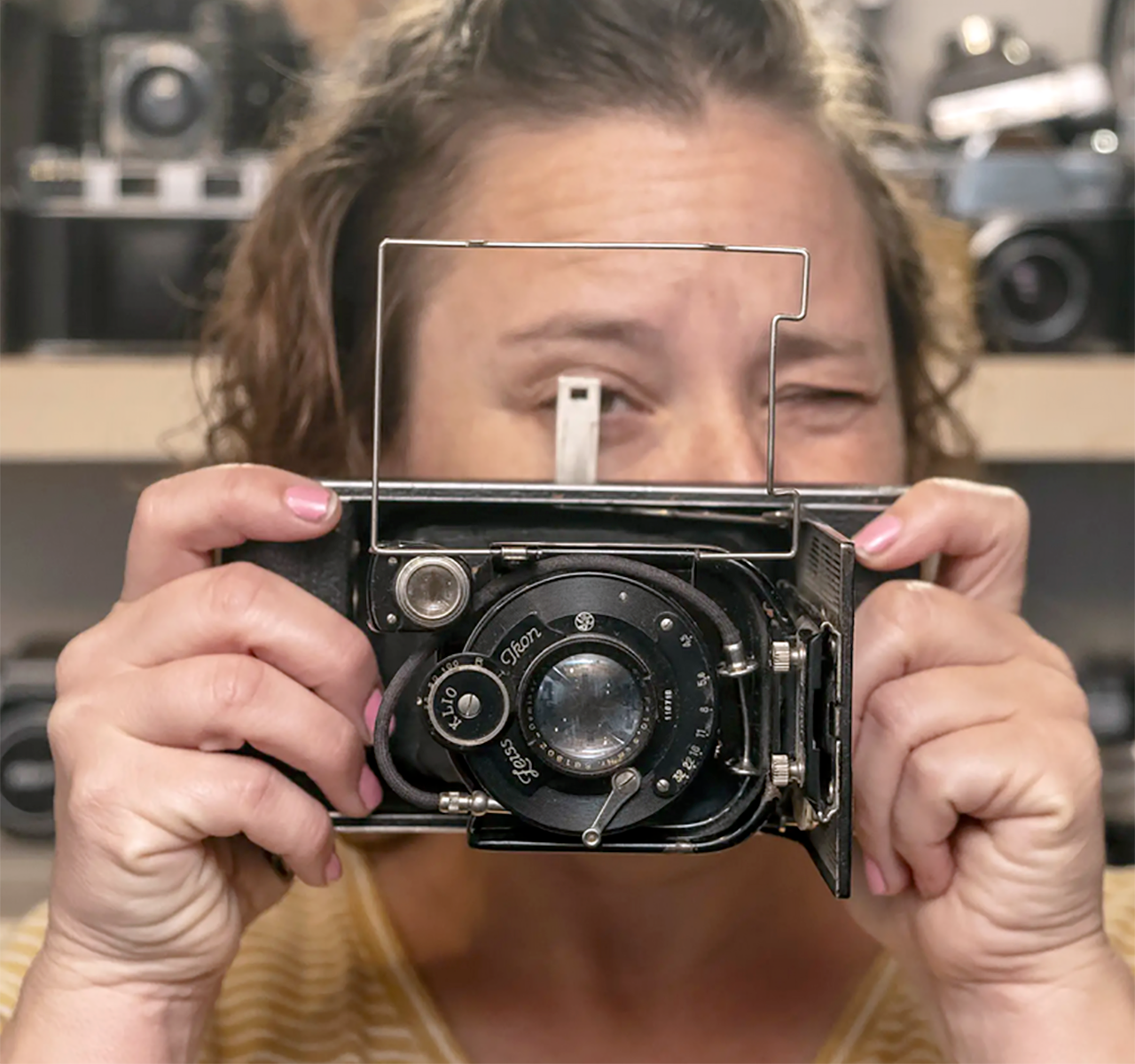
Way back in those good old days
The hinged wire frame finder of many folding cameras of the “roaring twenties” has to swung out so that it sticks out to the side of the camera. Lift the peep hole finder on the back of the camera as far as it will go. Position your eye as close as possible behind the peep hole so that you can see the entire wire frame through the peep hole. Anything you see within the wire frame is what will be captured by the lens.
Over the years, many different manufacturers have offered many different types of accessory viewfinders that have taken on numerous forms. Hundreds of different viewfinder models have been made over the years. They have even become the subject of entire collections. It’s impossible to give a complete overview here. So, it has to be exemplary.
Unlike early viewfinders that consist only of wire frames of appropriate sizes or even simple optical viewfinders that contain a magnifying lens element, you’ll find here viewfinders from eight decades, the oldest (the venerable Leica VIOOH) being a design from 1940 and the last one before the digital age began, the honourable xxx from . They all reflect in their own way the state of the art of their time.
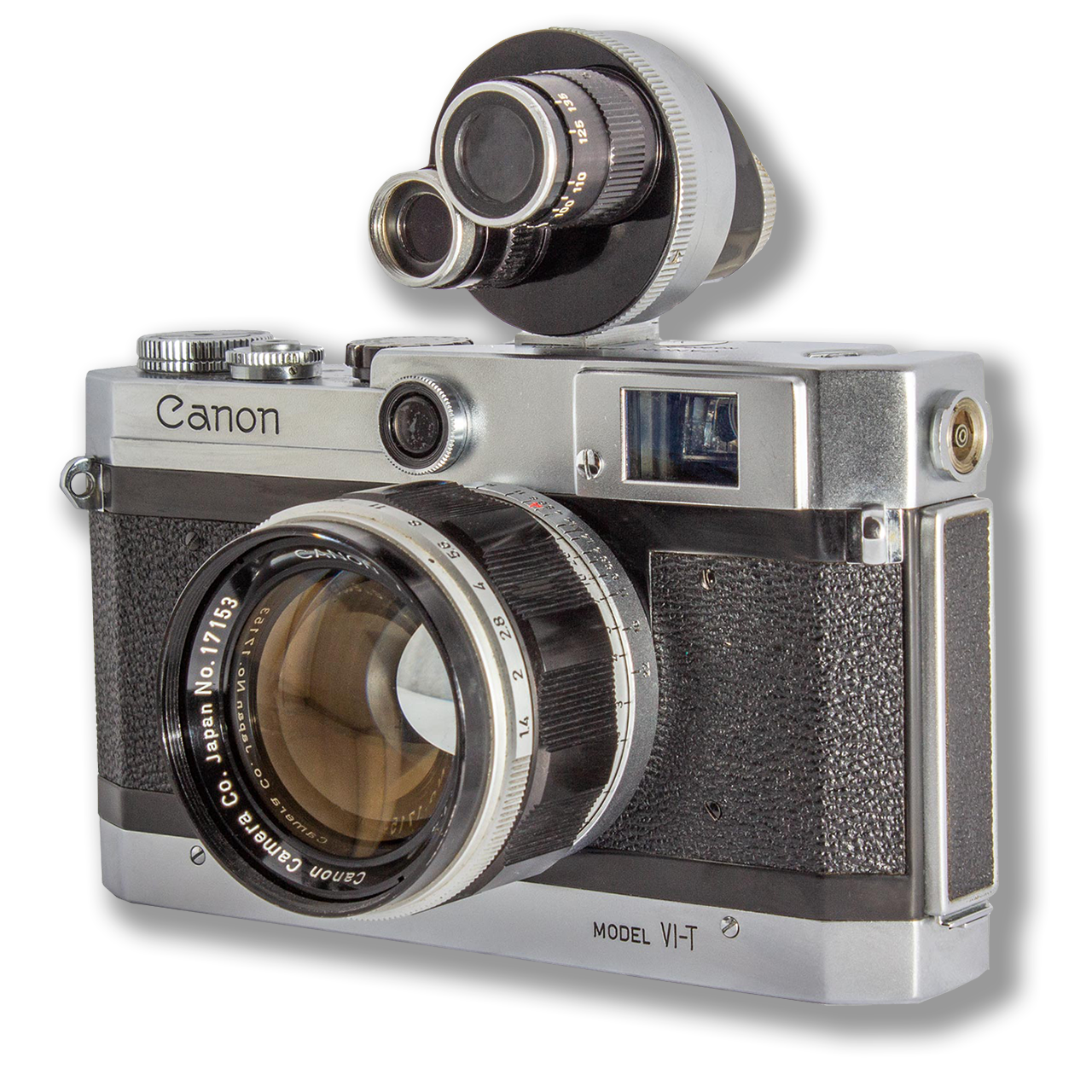
The Canon-P viewfinder has framelines for 35, 50, and 100mm lenses.
Soon after the appearance of the Leica 35mm camera in 1923, there appeared easily interchangeable lenses of different focal lengths for this and similar cameras, such as the Leica and Zeiss Ikon Contax lines. This became a great advantage to these cameras. However, it also created the need for properly adjusted framing with different lenses over a range of focal lengths.

The need for an accessory viewfinder and rangefinder was thus born and many were brought to the marketplace with a wide variety of creative designs. Creative designs not only in the mechanical sense but also optical designs.
Some fine viewfinders were offered by Leitz and Zeiss Ikon which were surprisingly basic in their design using nothing more than variable framing of a fixed field of view. Other companies such as Kodak and Argus, not normally considered to be comparable to Leitz or Zeiss, produced viewfinders as well as rangefinders of high quality applying optical designs significantly more sophisticated than either of their German competitors.
For the rare cameras of the 1940s and 1950s that had interchangeable lenses, it was unlikely to have a built-in viewfinder that showed framelines or coverage for the lens that you chose.
Even the venerable Leica IIIf and Nikon S2 cameras, for example, only showed coverage for 50mm lenses. If you had a 35mm or 135mm lens attached, you’d had to use an auxiliary external viewfinder. It wasn’t until the Leica M3 (or Nikon SP) that you had projected framelines for anything other than 50mm.
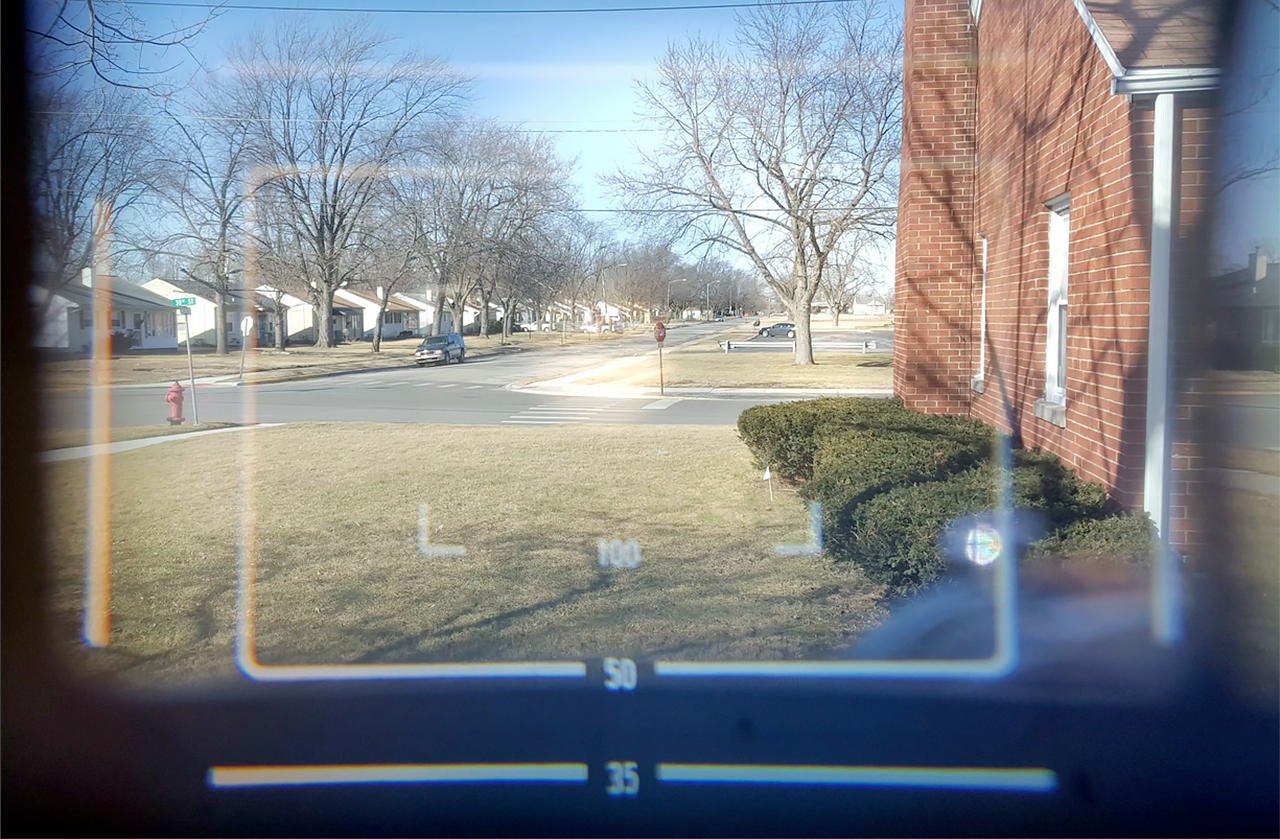
Parallax error (from parallel axis) is an effect in photography where the image seen in the viewfinder is not framed the same as the image seen through the lens, because the viewfinder is in a slightly different position to the lens. A shoe-mounted external viewfinder is positioned directly above the lens on many cameras, so there’s no horizontal parallax error, just vertical.
This effect is most noticeable with subjects close to the camera, and becomes relatively insignificant at longer distances. All cameras with separate viewfinder and taking lens suffer to some degree from parallax error. Cameras which view the scene through the taking lens, i.e. SLRs and view cameras, don’t have these parallax problems.
Some viewfinders offer “parallax correction”; this may be some method of shifting the image in the viewfinder, tilting the viewfinder or markings to allow the photographer to frame their shot normally, then shift across to the correction marks to compensate for the parallax.

If the axis of the viewfinder and the lens are parallel they will never see the same part of the view before them. The viewfinder must be tipped down slightly to bring the views into allignment. However, if the view in the distance is the same for both then the closer view will still be out of allignment. The amount of the “tipping” is different for every distance.
The site http://www.earlyphotography.co.uk/site/accnot.html contains an excellent description of the construction of a number of types of viewfinders. I have taken the liberty of copying the text here in its entirety.
The term ‘view-meter’ usually described a hand-held finder used to assess the scene and the best viewpoint and, if adjustable, which lens to use. A view-finder referred to a finder attached to a camera showing what will appear on the negative, but the terminology was not rigid. The main types are described below:
Frame Finders
 These have no lenses and consist of a rear sight and a frame some distance to the front marking the subject area. Often the sight is adjustable for parallax. Available in hand-held form from the 1850s.
These have no lenses and consist of a rear sight and a frame some distance to the front marking the subject area. Often the sight is adjustable for parallax. Available in hand-held form from the 1850s.
An unusual arrangement was fitted to some pre-war Rolleiflex cameras, there was no back sight, the frame carried at its centre a small concave mirror with a hole in its centre. The photographer looked into the mirror and centred the reflected image of his eye with the small hole.
Reflecting
 A positive lens in front of a mirror casts an image on to a horizontal ground glass screen, the lens might be adjustable for rising front. Parallax correction lines were sometimes marked on the screen or, rarely, the lens may be movable. The image is upright but laterally reversed. Largely replaced by the Brilliant finder.
A positive lens in front of a mirror casts an image on to a horizontal ground glass screen, the lens might be adjustable for rising front. Parallax correction lines were sometimes marked on the screen or, rarely, the lens may be movable. The image is upright but laterally reversed. Largely replaced by the Brilliant finder.
Brilliant
 Similar to the reflecting finder but with a positive lens in place of the screen. The image is upright but laterally reversed. Adams & Co. claim to have introduced this type of finder in 1894, which may be the case. From that time the brilliant finder started to replace the reflecting type. Beck introduced an improvement by raising the top lens and including a frame-mask at the focal point of the object lens to give a much clearer outline of the field of view. Large brilliant finders were used on some twin-lens reflex cameras such as the Voigtländer Brilliant.
Similar to the reflecting finder but with a positive lens in place of the screen. The image is upright but laterally reversed. Adams & Co. claim to have introduced this type of finder in 1894, which may be the case. From that time the brilliant finder started to replace the reflecting type. Beck introduced an improvement by raising the top lens and including a frame-mask at the focal point of the object lens to give a much clearer outline of the field of view. Large brilliant finders were used on some twin-lens reflex cameras such as the Voigtländer Brilliant.
Prism
 Pentaprism These were intended as waist-level finders, a pentaprism (five parallel sides) is used to produce an image that is upright and not laterally reversed. A negative lens may be in front of the prism to determine the field of view. This type of prism was first used (on cameras) by Adams in the Rectiflex finder. Later models were the Aufsu for the Leica. Despite giving a much clearer image than brilliant finders they did not prove popular.
Pentaprism These were intended as waist-level finders, a pentaprism (five parallel sides) is used to produce an image that is upright and not laterally reversed. A negative lens may be in front of the prism to determine the field of view. This type of prism was first used (on cameras) by Adams in the Rectiflex finder. Later models were the Aufsu for the Leica. Despite giving a much clearer image than brilliant finders they did not prove popular.
Richard Roof Prism
This is a prism with four triangular faces – two reflecting surface (the roof), an entry and an exit surface. It was intended to replace the mirror of a waist-level finder. The prism deflects the image through 90 degrees and corrects the laterally reversed, inverted image produced by the front lens. The description shows the prism sitting behind a positive lens and below a ground glass screen or a lens, mirrors could have been used in place of the prism.
Double Mirror
There were surprisingly few designs for waist-level finders employing two mirrors enclosing an acute angle, one design made use of curved mirrors.
Curved Mirror
This comprises a doubly curved mirror and a sighting post. The finder is used at chest level. The mirror is set at 45 degrees, from the side, in vertical cross section it is concave, from the front it is convex in cross section (a saddle surface). The finder gave an upright, laterally correct image. A small horizontal post was used to align the eye to the centre of the mirror.
Direct Vision (Eye-level)
- Single Lens A concave lens usually having cross hairs giving a reduced image of the field of view. Popular in the 1890s.
- Lens/Post Similar to the above but with a rear sight added.
- Post/Lens The reverse arrangement to the above, more popular on continental cameras than in Britain.
 Lens/Lens (Reverse Galilean) Consists of a front negative lens and a positive rear lens. Sometimes enclosed in a tube. The rear lens may be of blue glass to remove tonal values. This basic finder was later developed to include suspended frames for different lenses.
Lens/Lens (Reverse Galilean) Consists of a front negative lens and a positive rear lens. Sometimes enclosed in a tube. The rear lens may be of blue glass to remove tonal values. This basic finder was later developed to include suspended frames for different lenses.- Without lens Consists of a simple tube with a mask to outline the field of view, sometimes with plain glass, front and rear. This could be considered a frame finder but was much smaller. Used on Periflex cameras with long-focus lenses.
- Telescope, Monocular Consists of a miniature telescope or monocular with a positive objective lens, eyepiece and probably an image erecting prism.
- Universal Similar to a lens/lens type but for multiple focal lengths. The simplest has the field outlines for several lenses drawn on a transparent mask. The Leitz Vidom finder had two L shaped masks which were slid together or apart as the lens was selected; the image remained the same size but the image frame changed. The front, image forming, lens was converging, an erecting prism (Dove type) was fitted giving an upright but reversed image. Zeiss used a fixed rear component with several converging front components of different strengths, this had the advantage that the image size changed within a fixed frame. Porro prisms erected and reversed the image. Another option was a varifocal arrangement having a moving lens component, used on the Kodak Ektra.
Albada
 The original pattern had a semi-silvered lens with a concave inner surface but of neutral power placed a short distance in front of an opaque sheet with a sighting hole at its centre. The inner surface of the sheet was black with an outline of the field of view in white. The finder was open, the field of view outline was reflected by the semi-silvered lens back to the eye making it appear suspended on the subject. Several variations exist notably combining it with a lens/lens type finder. The field of view outline for several lenses or images sizes were often combined in one finder. First used on accessory finders for the Contax, 1932, and then on the Contaflex, 1935.
The original pattern had a semi-silvered lens with a concave inner surface but of neutral power placed a short distance in front of an opaque sheet with a sighting hole at its centre. The inner surface of the sheet was black with an outline of the field of view in white. The finder was open, the field of view outline was reflected by the semi-silvered lens back to the eye making it appear suspended on the subject. Several variations exist notably combining it with a lens/lens type finder. The field of view outline for several lenses or images sizes were often combined in one finder. First used on accessory finders for the Contax, 1932, and then on the Contaflex, 1935.
Suspended Frame
A development of the Albada finder was to display frame markings within a Direct Vision finder of the reverse Galilean form. A separate window with diffuser illuminated the frames which were superimposed in the finder by a semi-silvered mirror or similar. Frame markings for different lenses could be displayed selectable by interchanging the camera lens, this was usually achieved by a masking plate moving relative to the plate carrying the frame outlines but optical arrangements were possible. When integrated into the camera, compensation for parallax and field reduction when focusing at close distances might be included.
Direct Ground Glass
A positive lens giving an image on a ground glass screen. A mirror may be placed behind the screen.
Opaque
A positive lens is focused on a ground glass on which is drawn an outline of the field of view. The subject is viewed with one eye direct, the other looks into the finder. The two images merge to give an outline of the image area superimposed on the subject. Never popular but used on the Kern Bijou of the early 1920s. A variant was the opaque spot without an outline used on the 1895 model Verascope.
Parallax
Parallax, the difference in view point of the camera lens and the finder, was overcome in several ways. The simplest was to manually tilt the finder, on frame finders the rear sight could be raised. Automatic correction was provided on some twin-lens reflex cameras, on the Rolleicord masks in the view-finder were adjusted by the focusing mechanism, on the Voigtländer Superb the viewing lens tilted. The first rangefinder camera with parallax correction was the Kodak Ektra, 1941, where a movable lens, inside the finder, was coupled to the focusing mechanism. Other cameras used a movable frame. Leitz produced a variable length extension tube for close-up work in 1935 (nooky) with parallax correction by a moving frame, the frame also compensated for the reducing field of view. A thin wedge in front of the rangefinder window allowed the rangefinder to be used to focus.
Rising Front
With a brilliant or reflecting finder, raising the front lens would show the effect of rising front. On some finders this was manually adjusted (e.g. Sibyl) on others such as the Adams Identoscope finder the lens was connected by levers to the rising front and was adjusted automatically. Thornton-Pickard proposed having a plumb bob visible in the finder so that tilting the camera would register the amount of back tilt needed to keep the image vertical. In the finder of some Linhof cameras a pendulum shows whether the camera is tilted.
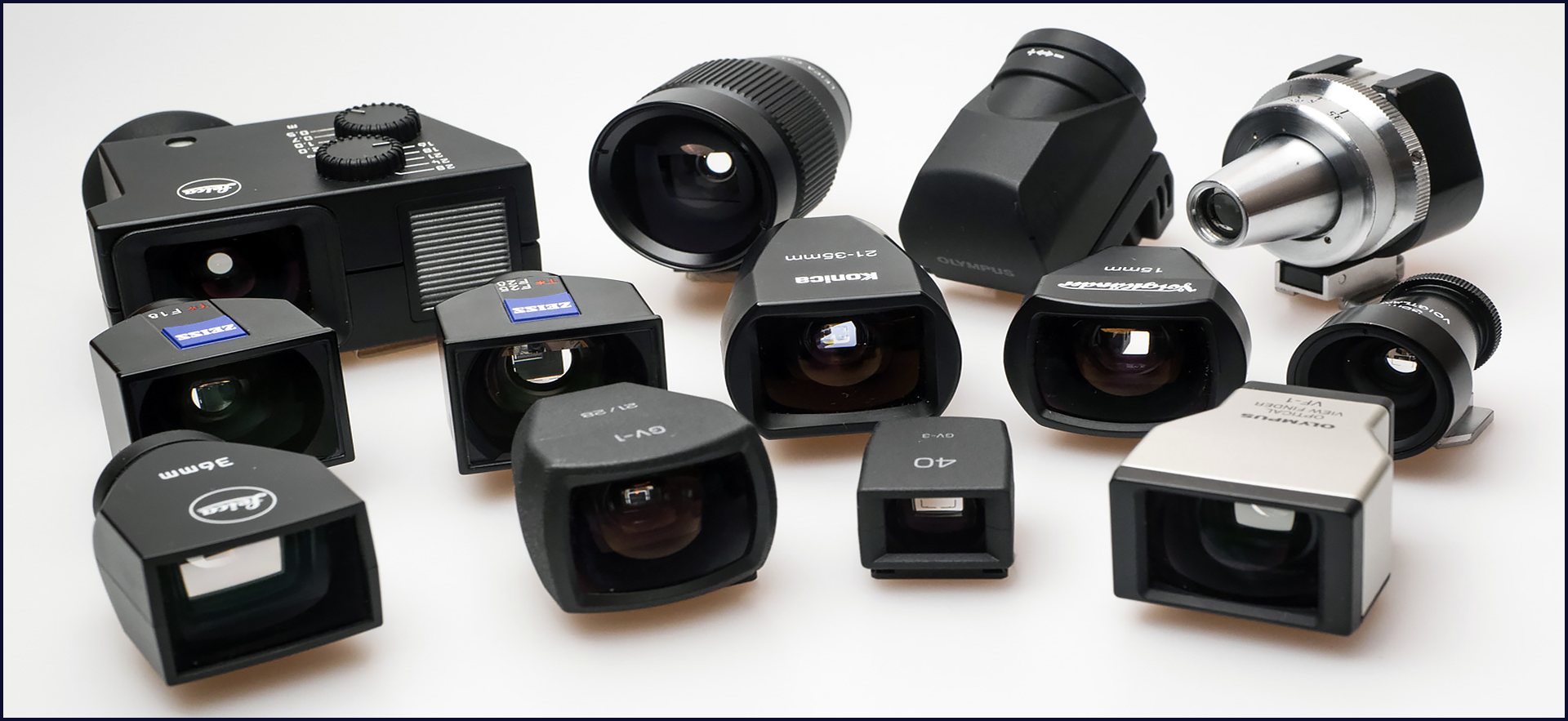
Most of the rangefinders of this survey come from the sites of messsucherwelt.com, cameraquest.com and earlyphotography.co.uk
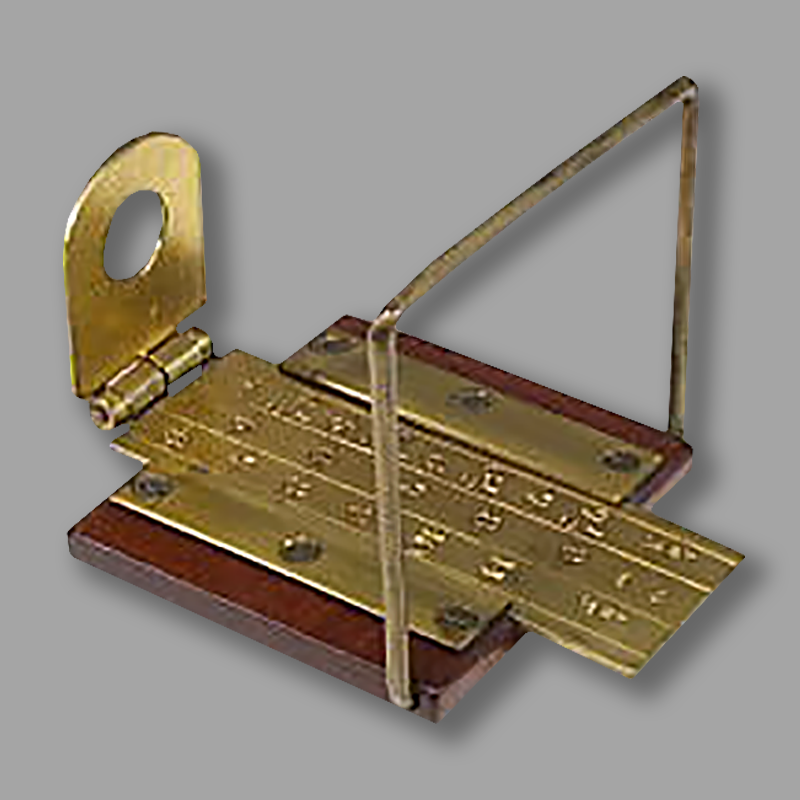
Heywood-McKellen Finder
This instrument is a combination of a frame finder and view-meter and was made by S.D. McKellen Ltd., 24 Market Pl., Manchester.
It is suitable for quarter-plate cameras with 4″ to 7 ½” lenses; 5″ x 4″ cameras with 5″ to 9″ lenses and half-plate cameras with 6″ to 11″ lenses.
It was made from mahogany and brass. It has a dovetail fitting to a plate on the camera.
- Origin: Manchester, England
- Year: 1897
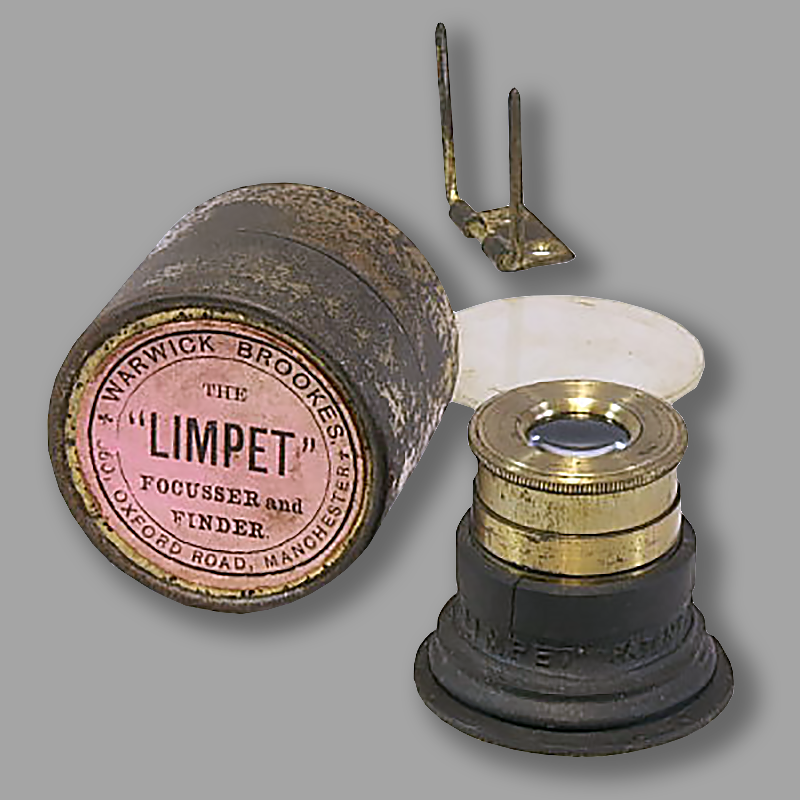
Limpet
This is a combined focusing magnifier and view-meter. It is based on a patent by Warwick Brookes for a suction device to attach items to glass. As a focusing magnifier it is simply attached to the focusing screen.
When used as a view-meter it clips into a wire holder mounted on the camera and a piece of ground glass is attached to the rubber rim of the finder. The price was 2/6.
With: Holder to attach to the camera, ground glass screen. Tin container with Warwick Brookes label (Address on container: 350 Oxford Rd.), the instructions are printed on the inside of the container.
- Origin: Manchester, England
- Year: 1891
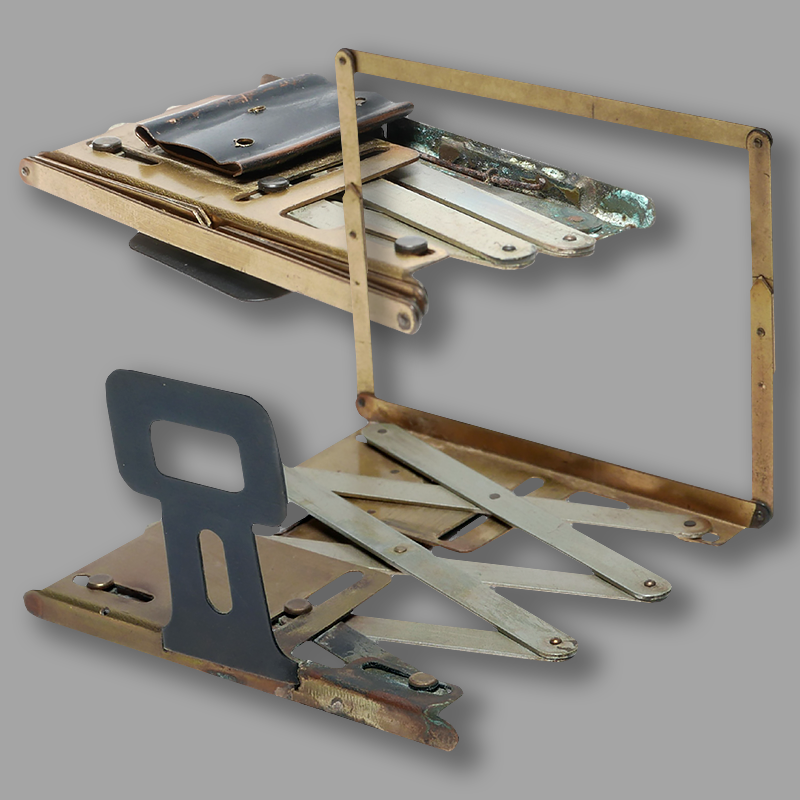
Sinclair View-finder, style 2
Folding frame finder manufactured by James A. Sinclair & Co. Ltd. between 1910 and 1920.
The finder is of the so-called lazy-tong construction (lazy-tong = a series of jointed and pivoted bars capable of great extension used to handle something at a distance), adjustable for different angles of view.
Two image ratios were available, style 1 for quarter-plate etc. and style 2 for vest-pocket and postcard. These were for hand-held use as a view-meter to determine the viewpoint or as a conventional view-finder attached to a camera.
- Origin: London, England
- Year: 1912
- Price 5/-
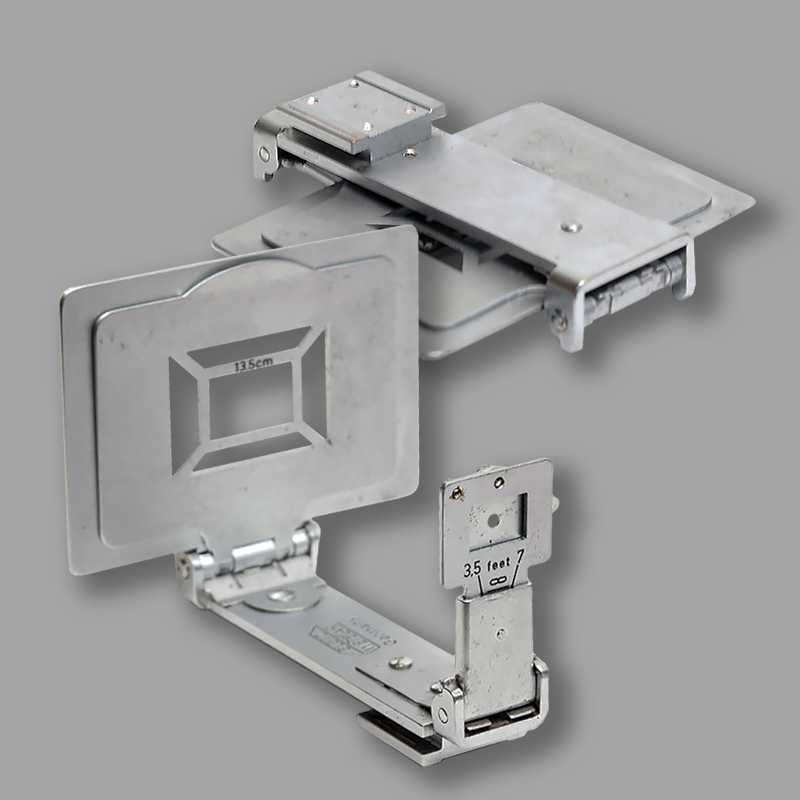
Leitz folding frame-finder for the Leica camera
What is particularly notable about this frame finder is the versatility of its application. Because it can not only be used for the standard lens with a focal length of 5 cm, but also shows the image field for the “Elmar” 3.5 and 9 cm lenses and the “Hektor” 7.3 cm lenses.
By inserting a special field stop, it can also be set up for the “Elmar” 10.5 and 13.5 cm long-distance lenses, which are very often used in sports photography. Parallax in close-up shots can be compensated for by vertically adjusting the sight frame. This folding frame-finder is highly recommended for sports photographers and for taking photos from airplanes.
- Origin: Wetzlar, Germany
- Year: 1933
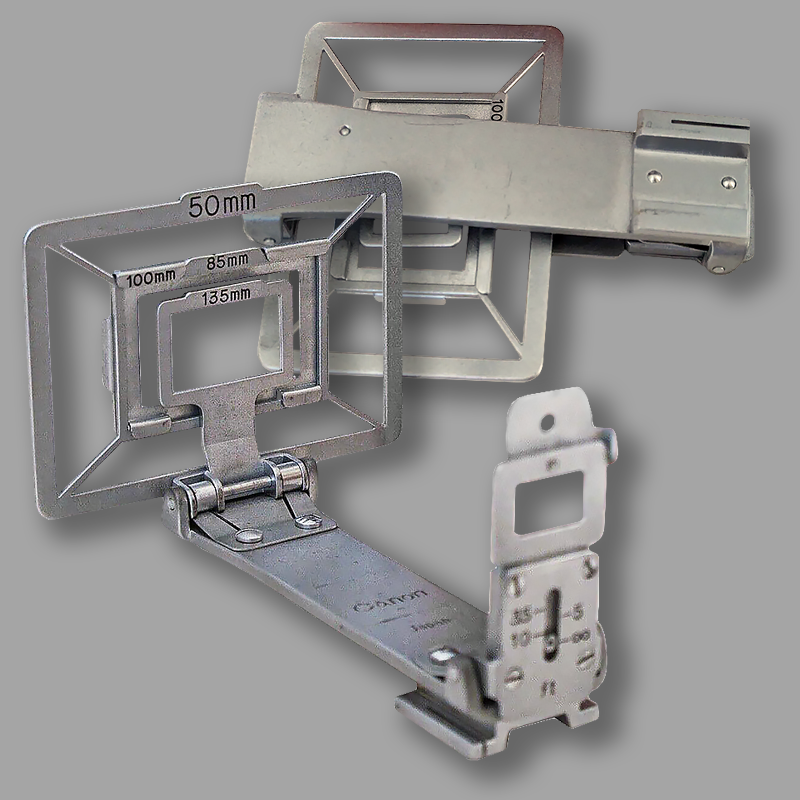
Canon Universal Frame Finder
In Canon’s 1955 catalogue is a listing for the Universal Frame Finder Model III. This ‘wire frame’ viewfinder was especially suitable for “fast moving action such as sports events and night photography”. The idea was that you could use your peripheral vision to see what action was about to move into the frame thus making it easier to track it.
Field of view is variable for lenses with focal lengths of 50mm, 85mm, 100mm and 135mm. It also has a pinhole that could be lowered into the eyepiece and it had a rudimentary parallax correction feature which worked by moving the eyepiece up or down based on the engraved scale. The price for the Model III was $7.50 in 1955.
- Origin: Tokyo, Japan
- Year: 1955

Rhaco III Viewfinder for plate cameras
This is a tubular direct vision finder of the lens/lens type, manufactured by Richard Hennig, Frankfurt am Main, Germany.
The eyepiece is of blue glass. The viewfinder is provided with a spring clip to attach it easily to the side of a camera. You simply clip it onto the housing of a camera. Thereafter the camera can be used from eye level.
The viewfinder shows a smaller but still clearly visible image. An integrated crosshair is intended to make image composition easier. As can be seen from the catalog text, it can be used for formats from 4.5×6 cm to 10×15 cm.
- Origin: Frankfurt am Main, Germany
- Year: 1930s
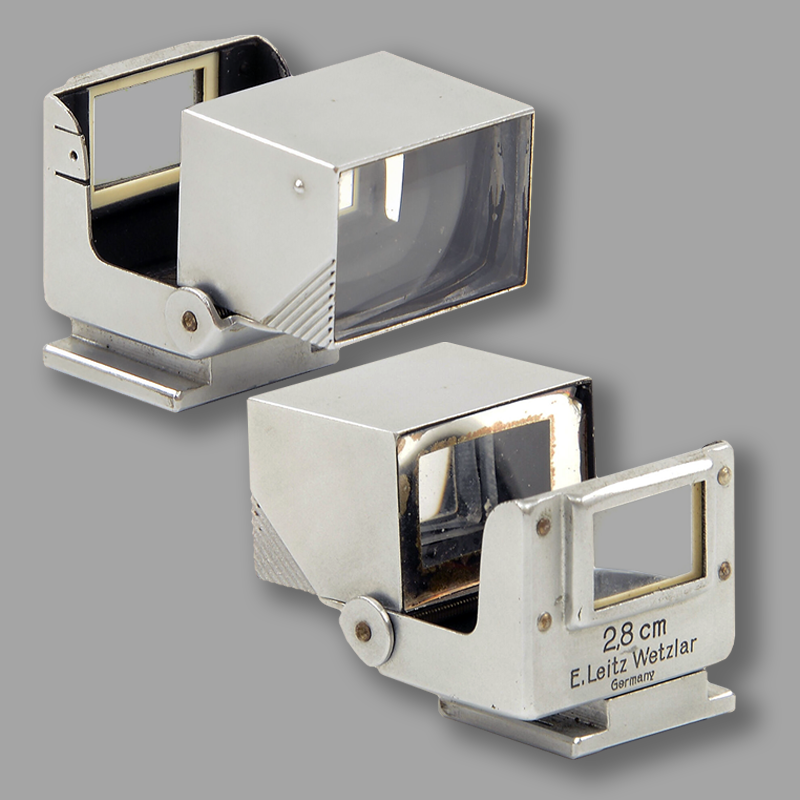
Leitz SUOOQ Folding Finder
In the introduction brochure for the Hektor-lenses, dated September 1935, the folding Finder type SUOOQ is mentioned as the matching finder. This was a 28mm folding finder with parallax adjustment in meter.
The finder was available as well as in black as in chrome finish. Black version costed $22.50; the chrome counterpart $24.60.
Also, it seems likely that Leitz would not want a waist level finder to be the “normal” finder, but rather an accessory for a unique camera holding position. The SUOOQ was discontinued about 1943 along with a couple of sport folding finders.
- Origin: Wetzlar, Germany
- Year: 1935
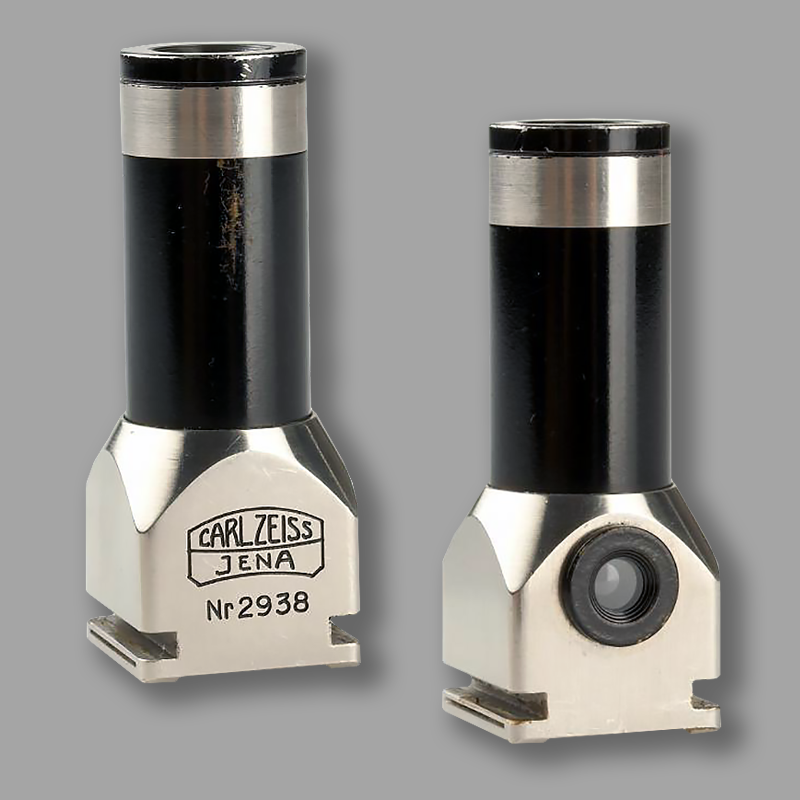
Zeiss Waist Level Finder type 436/2
Before the second Worldwar built Zeiss Ikon cameras at all levels of price and features in Wetzlar, Germany, from the fabled Contax, Contarex and Twin Lens Contaflex cameras that many photographers dreamed of owning, but few could afford, to the simplest box cameras and folding cameras.
Zeiss built a Waist Level (lighthouse Chimney) style viewfinder 436/2 in black and nickel for 5cm lenses. The nickel version was made for the export market.
The 436/2 was replaced by the 436/5, which rotates to the side to work as a right angle finder. It was also delivered in black and chrome execution.
- Origin: Wetzlar, Germany
- Year: 1934
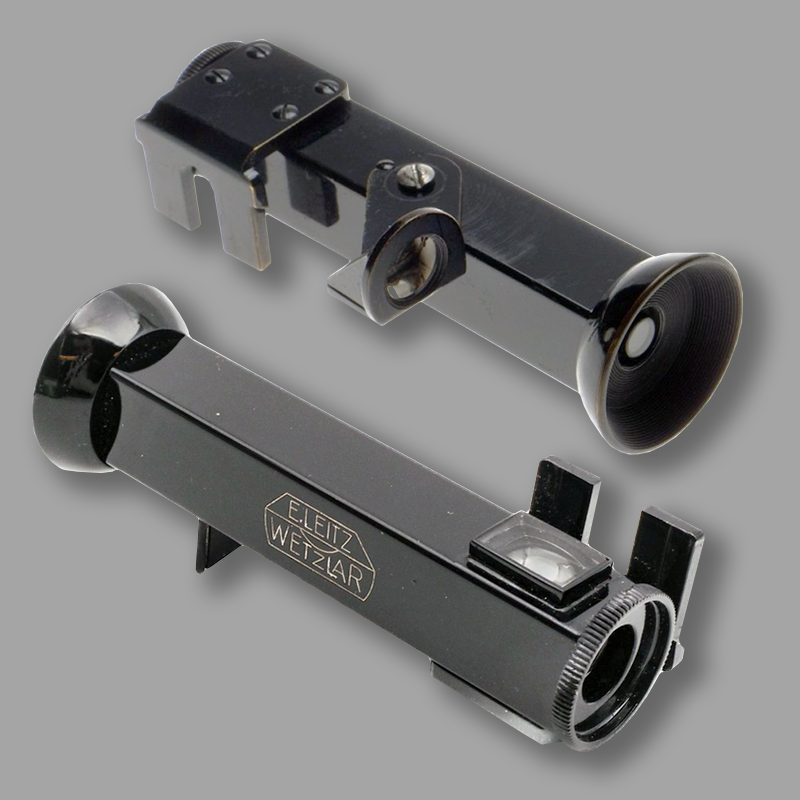
Leitz WINTU right-angle viewfinder
The Wintu right-angle viewfinder allows unobtrusive shots to be taken at right angles to the subject, meaning you can use it to take photos “around the corner,” so to speak. For unobserved and natural people and genre shots, street scenes, etc., it cannot be beaten.
When taking such pictures you have to be able to focus the lens at a right angle too. This is achieved by a small prism in front of the rangefinder when the right-angle finder is placed on it. The measurement is made easier if you first sight the object in the right-angle finder and then focus in the prism in the usual way. This finder can only be used for Leica lenses with a focal length of 5 cm. The viewfinder image is reversed.
- Origin: Wetzlar, Germany
- Year: 1933
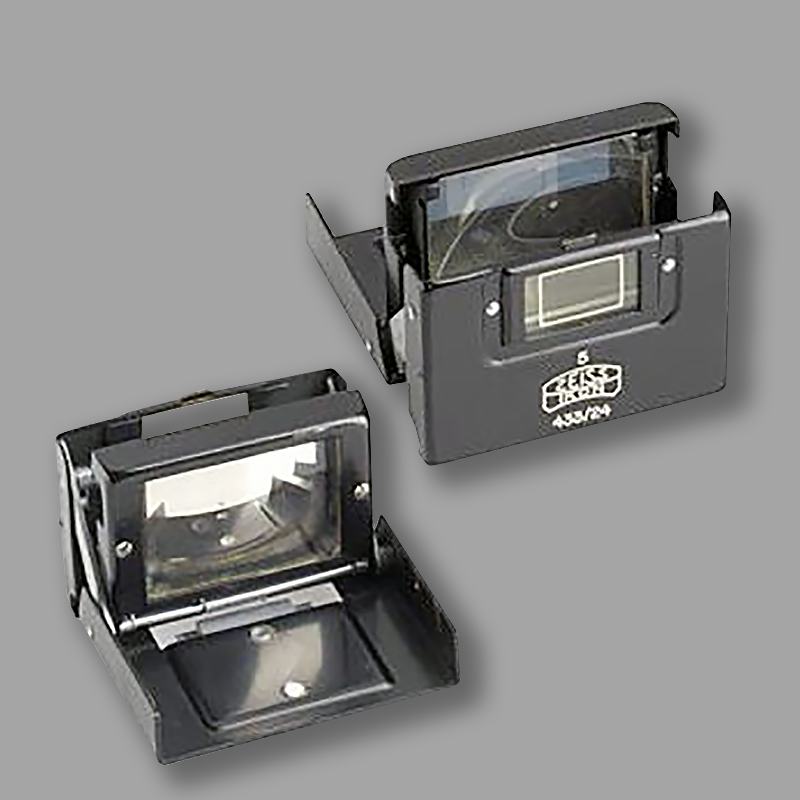
Zeiss Ikon Albada Finder type 433/24
This collapsible Albada finder, manufactured by Zeiss-Ikon A. G., was suitable for shooting 6 x 9 cm images.
An Albada viewfinder, designed by the Dutch inventor L.E.W. van Albada, is a viewfinder that has a special mirrored lens that creates the illusion of a projected viewfinder tramlines when you look through it. It does this by reflecting white rectangular lines that are printed on a transparant bit of plastic near the eye piece.
These viewfinders which fitted the accessory shoe on the camera, were made in a lot of versions and as well in as well in black as chrome finish. Fits accessory shoe.
- Origin: Dresden, Germany
- Year: 1934 – 1940
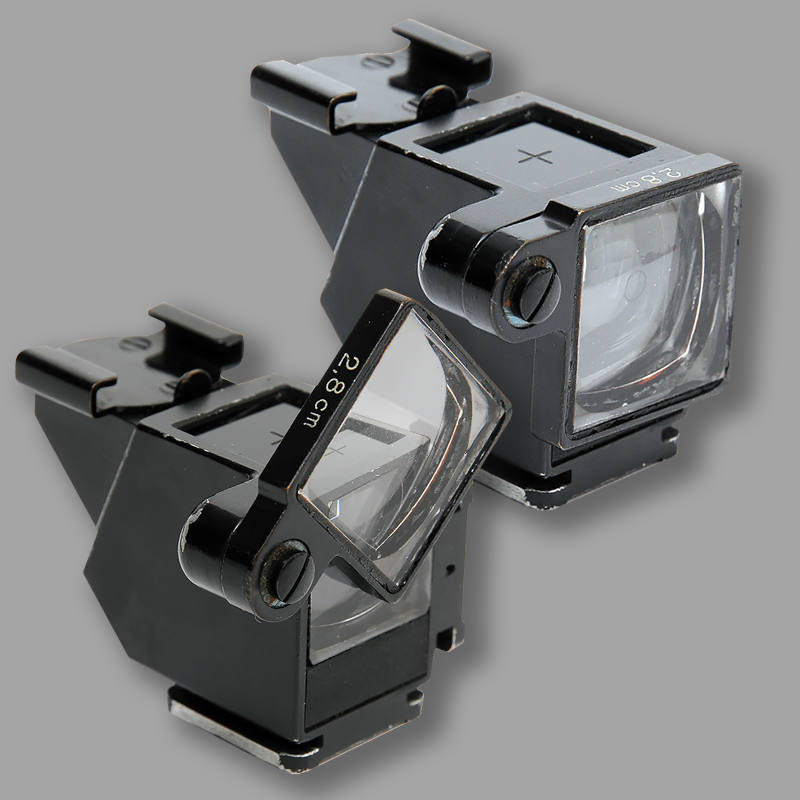
Leitz AHOOT reflecting (waist-level) viewfinder
The AHOOT first appeared in 1932 and was available to mid-war. Looking down on the finder a cross and a circle were visible. The cross had to entered in the circle when composing the picture.
In those pre-war days the choice in the Leitz waist-level viewfinder programme was between the simple AUFSU, which had no accessory shoe nor a cross and circle in the finder, the AYOOC and the AHOOT. The model AHOOT was similar to the AYOOC, but had an extra front lens that could be swung-in to convert the field of view to 2.8 cm. All standard production viewers had a modified body casting compared to the AUFSU-viewer.
Origin: Wetzlar, Germany
Year: 1936
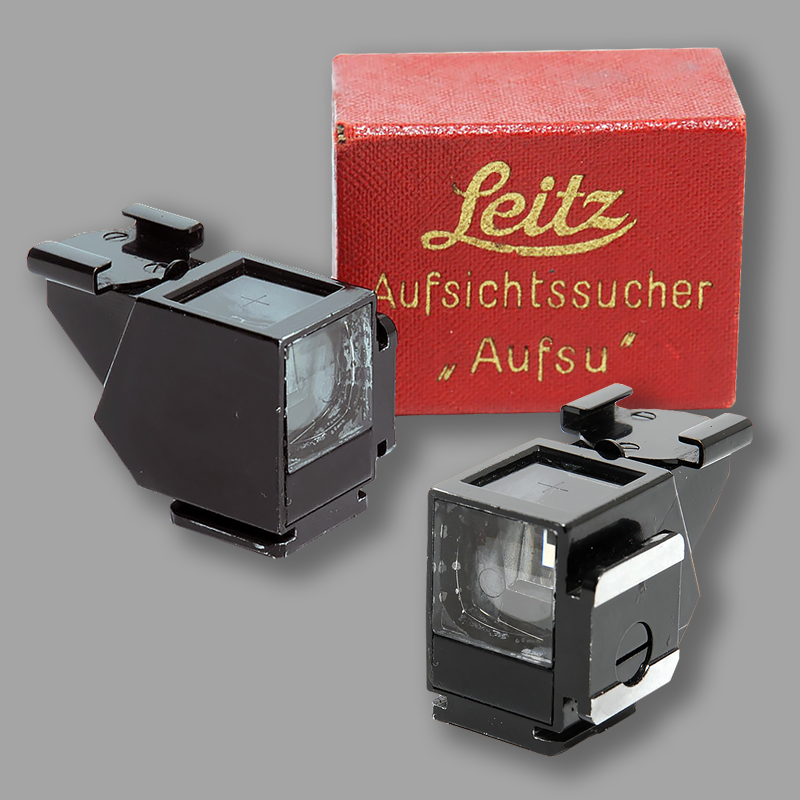
Leitz Aufsu brilliant viewfinder
In contrast to all other Leica viewfinders which are used close to the eye, this viewfinder is designed and used as a brilliant viewfinder. The image is therefore not aimed at eye level, but about 20 cm lower. This viewfinder will therefore be particularly comfortable where a deeper viewing angle is desirable, such as when taking photos of children and small animals. The Aufsu is one of the rarest of all Leica-finders of the regular models.
The viewfinder consists of a housing in which a so-called pentaprism is arranged in conjunction with a negative lens (Newton viewfinder). This combination produces a very clear, bright and sharply defined image.
- Origin: Wetzlar, Germany
- Year: 1925
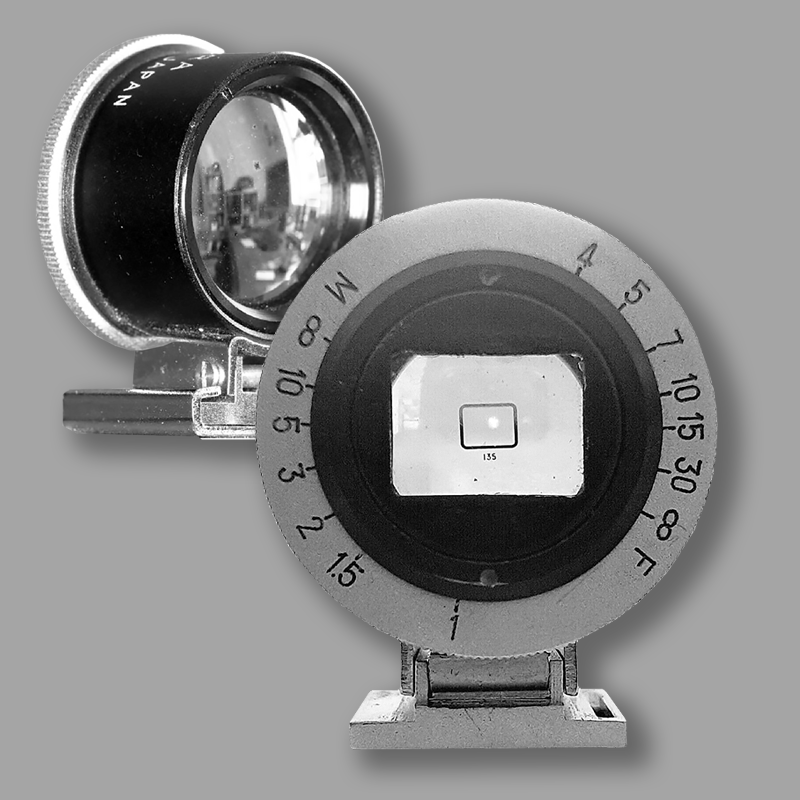
Komura clip-on viewfinder
Viewfinder cameras with interchangeable optics often only had a viewfinder for the normal lens of 45mm or 50mm. Clip-on viewfinders were used for the available wide angle 35mm or telephoto lenses 135mm.
A special form of these clip-on viewfinders are those that offered the possibility of compensating for the deviation of the lens axis from the viewfinder axis. To compensate, the viewfinder can be tilted depending on the object distance.
This Komura viewfinder was suitable for 135 mm lenses. It featured an illuminated telephoto frame and parallax adjustment.
- Origin: Sankyo Koki, Japan
- Year: 1958
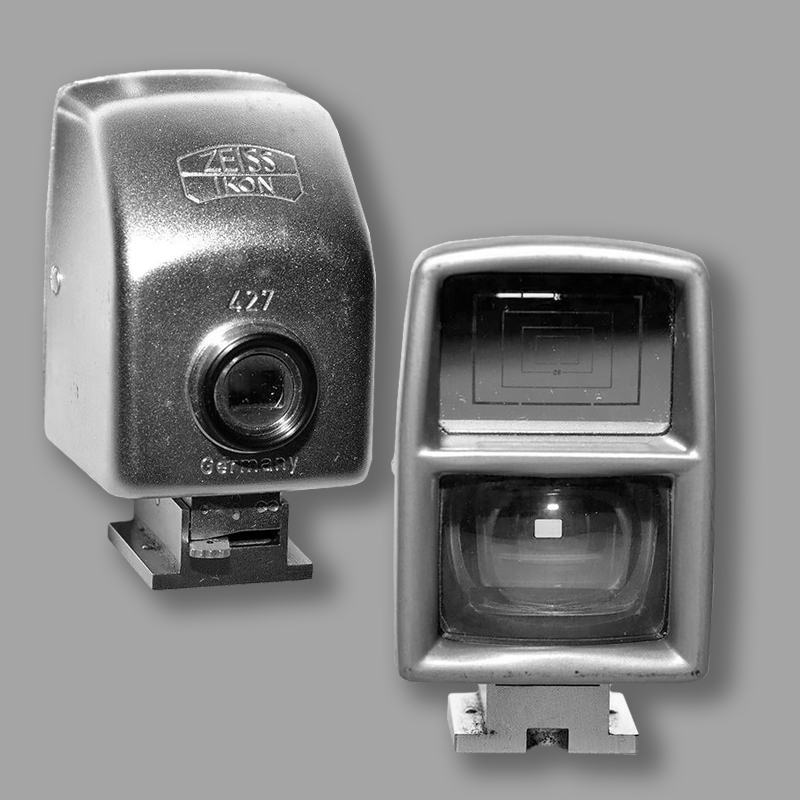
Zeiss Ikon Clip-On Finder 427
After World War II Zeiss Ikon was split into a West German and an East German part. Stuttgart became the company’s domicile; Jena became the East German domicile.
After the war, Jena produced this bright-line 427 multi-finder which covered 35, 50, 85 and 135 lenses and stereo field. It was one of the first finders they made.
The finder is equipped with parallax adjustment. The eye piece is threaded for eye-correction lens; the parallax correction ranges respectively from 3 to 6 feet, 6 to 13 feet and finally from 00 13 feet to Infinity. The price was then $25.00
- Origin: Zeiss Ikon Jena, Germany
- Year: 1955
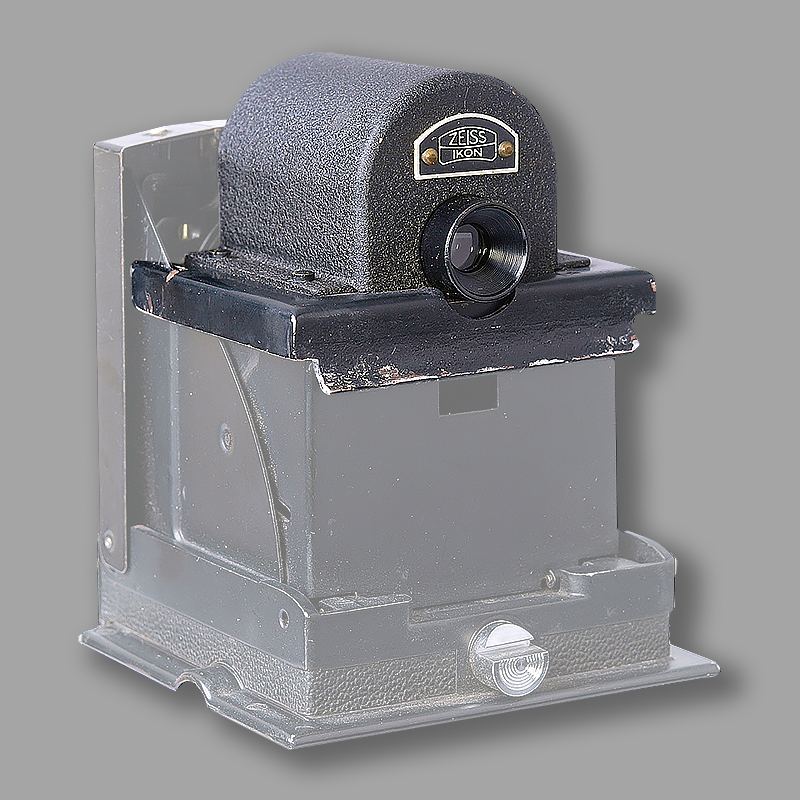
Prismatic viewfinder type 400/16
The prismatic viewfinder type 400/16 for the Zeiss Ikon Ikoflex 6×6 camera is especially designed for for focusing and viewing at eye level. With this attachment the sharpness of the picture can be constantly controlled at eye level. The object appears vertically and without reversal as from right to left. So, easy photography of moving objects.
The 400/16 finder is slipped onto the finder hood. Since the aperture of the viewing lens of the Ikoflex is not reduced, the viewfinder image of the 400/16 viewfinder will be sufficiently bright to permit accurate focusing even under poor lighting conditions. When using the prismatic viewfinder, the Ikoflex is operated as usual. Price of the 400/16 was $22.—.
- Origin: Zeiss Stuttgart, Germany
- Year: 1955
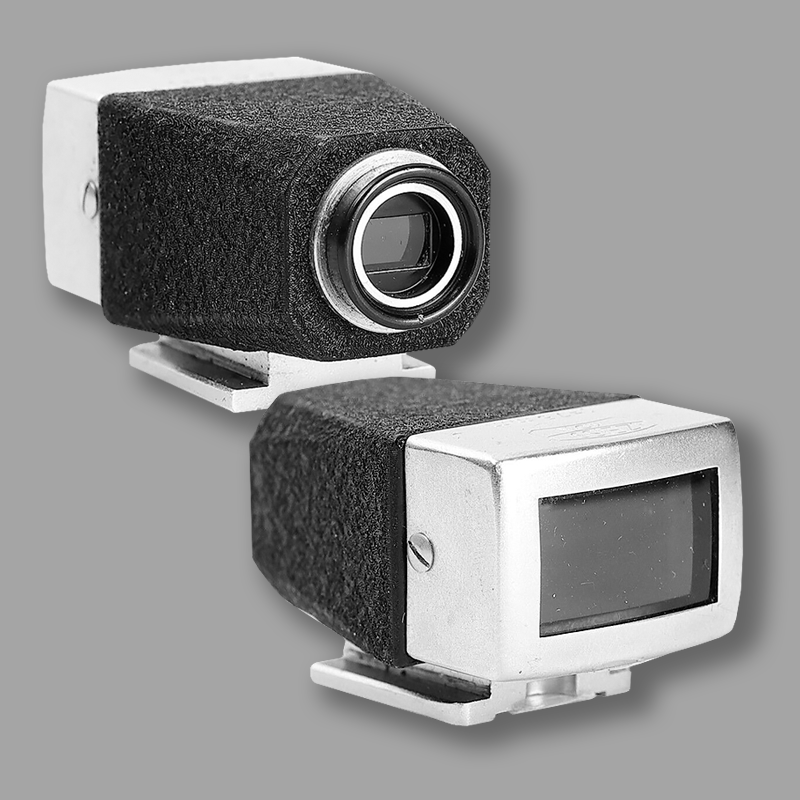
Direct Vision 75mm Finder model 423
After World War II Zeiss Ikon was split into a West German and an East German part. Stuttgart became the company’s domicile. Zeiss Ikon ceased the production of photographic products in 1972. This was a great shock for the entire German camera industry.
Zeiss Ikon viewfinders for the Contax came in many shapes and styles over the years, designed for different applications. But their purpose was singular, to show the field of view of one or more of the lenses that couple be mounted on the Contax. This viewfinder is the type 423. It was made for 75 mm lenses, probably for a Contina III camera.
- Origin: Stuttgart, Germany
- Year: 1956
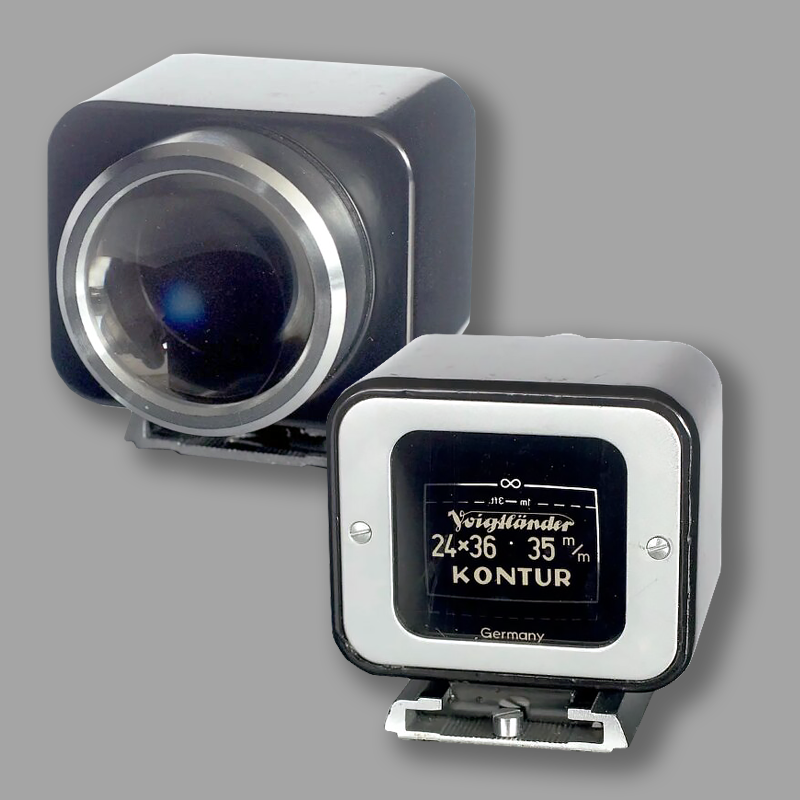
Voigtländer Kontur
After WW2, Voigtländer expended a great deal of effort to provide the best viewfinders for their cameras. The Kontur finder was one of their bests.
The Kontur is an opaque finder that projects an outline of the field of view (parallax markings), one eye looks into the finder the other at the scene. A further advantage of the Kontur finder is that if you wear glasses there is no need to take them off.
The Kontur was introduced in 1951 in 35mm and 50mm focal lengths for 35mm cameras and in 6×6 and 6×9 formats for 120 and could be used on other makes of camera with the appropriate focal length.
- Origin: Braunschweig, Germany
- Year: 1951
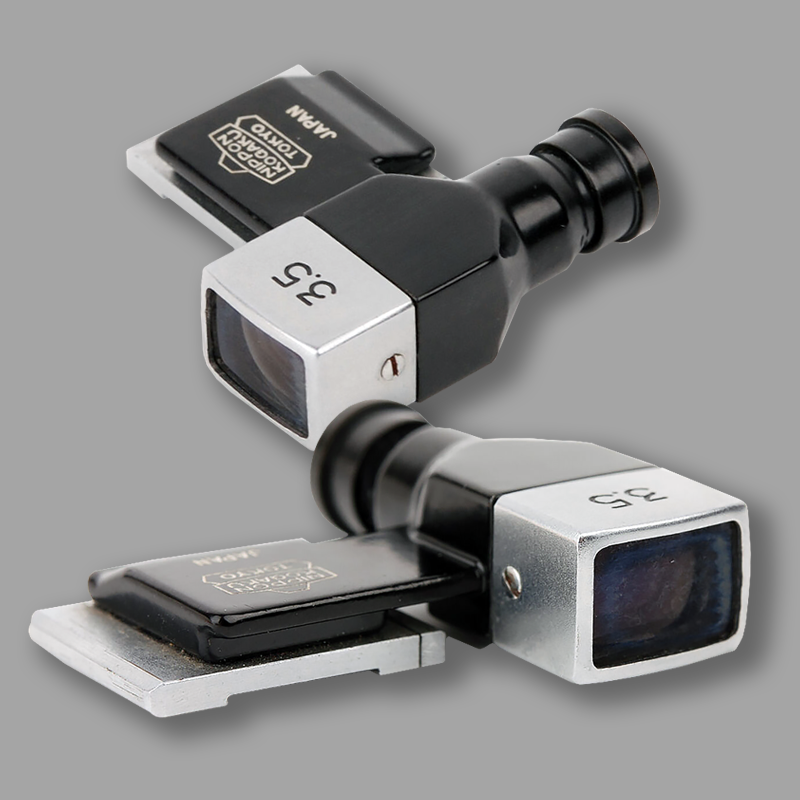
Nikon 35mm Minifinder
Nippon Kogaku, K.K., or Japan Optical Co., was formed on July 25, 1917, by the merger of three small optical firms, one of which dated back to 1881.
They introduced the 3.5cm Off-Set Minifinder for the Nikon S2 in 1956, and this finder was listed in price sheets until 1964. The original price was $11.75 It was designed to be left on the camera, while the everready case still could be closed.
As the Nikon SP was introduced in 1957, which had it’s own built-in 35mm finder, it’s usefulness was limited. It is now a rare and expensive item. Most examples do not have serial numbers, but if numbered, it can be found on the bottom of the foot.
- Origin: Nippon Kogaku, Japan
- Year: 1956
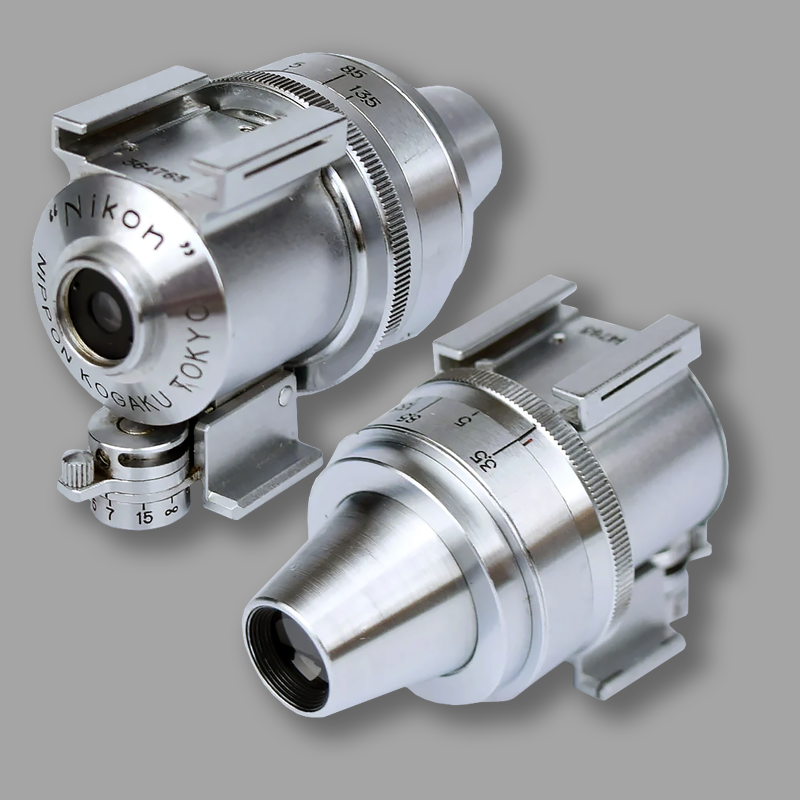
Nikon Variframe Viewfinder
Most Nikon rangefinder cameras after 1957 have built-in bright-line frame for visual composition and focussing. While an individual viewfinder is good for one single focal length, an universal finder type is designed for multi-focal lengths. Nikon offered two types of such viewfinders: the Variframe and the Varifocal Finder. The Variframe was the first one to offer multi-focal lengths framing guides in a single finder.
The Universal Variframe Finder varies the picture frame area in accordance to the field of view of the used lens, but the size of the viewer image always remains unchanged. This type #6 finder is one of the first Variframe finders with a nose piece for a 28 mm attachment.
- Origin: Nippon Kogaku, Japan
- Year: 195?
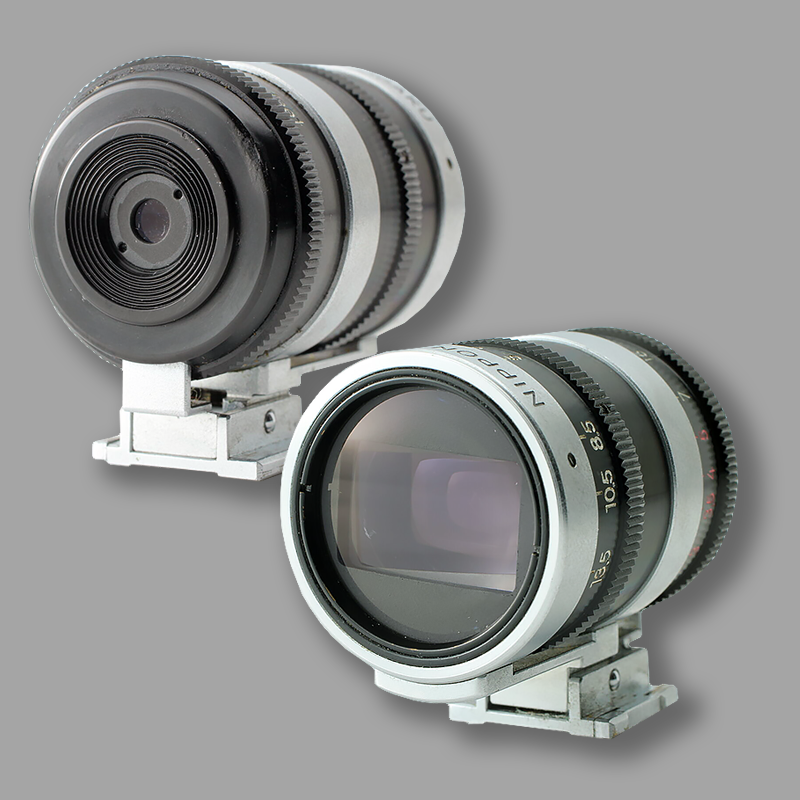
Nippon Kogaku Varifocal Finder
This is an early Nikon Universal Varifocal Finder in circular shaped construction. The Varifocal viewfinder is a universal finder that can be placed in the accessory shoe on top of any camera. It maintains a fixed picture frame and varies the size and area of the image within. Set the scales according to the focal length of the used lens (35-135 mm).
Users would prefer multipurpose universal finders like Variframe and Varifocal type for photography than single focal length finders (called “Individual Finder by Nikon). The Nippon Varifocal Finder can be regarded as more popular series of their multi-focal length finders.
- Origin: Nippon Kogaku, Japan
- Year: 19??
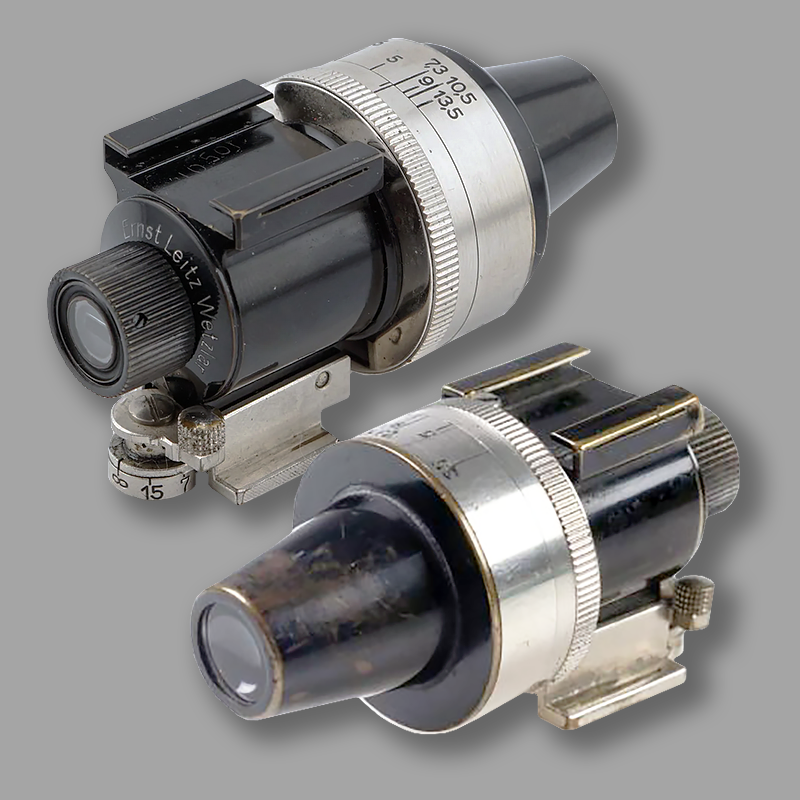
Leitz Vidom universal viewfinder
This Vidom viewfinder for all Leica lenses has a rectangular field stop that can be enlarged or reduced using a knurled rotating ring. The aspect ratio always remains 2 to 3. A scale indicating the different lens focal lengths is engraved on the rotating ring. So the aperture displays exactly the image field for the focal length to which the index line was set, e.g. for object distances from approx. 10m to ∞.
A second smaller index mark applies to close-up shots at 1.5 to 2 m; it shows the reduction of the image field for all Leica lenses with the exception of the wide-angle lens. When taking pictures at distances between 3 and 10 m, it is advisable to set the camera to the middle between the two lines.
- Origin: Wetzlar, Germany
- Year: 1933
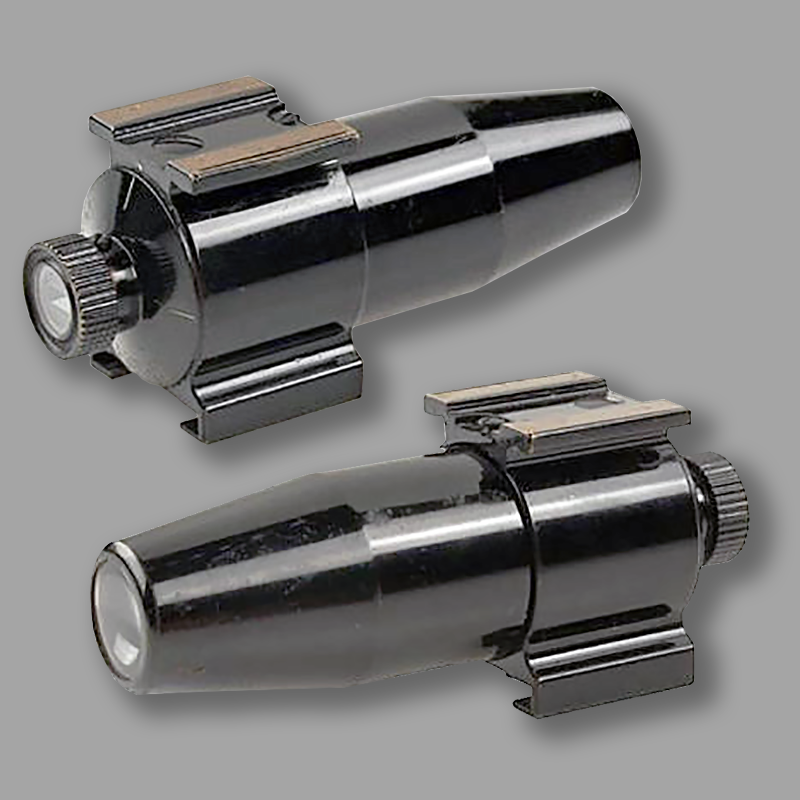
Leitz Viuna/Vizwo/Vitre/Vifur universal viewfinder
In contrast to the Vidom universal viewfinder, this viewfinder version is only intended for certain lens combinations.
The different image fields are marked on a graticule.
The universal viewfinder is inserted into the accessory shoe of a camera. It has a similar accessory shoe on its upper side, so that it can also be used in conjunction with a range finder.
There are four different versions:
• Model Viuna for 3.5, 5 and 7.3 cm;
• Model Vizwo for 3.5, 5 and 9 cm;
• Model Vitre for 3.5, 5 and 10.5 cm;
• Model Vifur for 3.5, 5 and 13.5 cm.
- Origin: Wetzlar, Germany
- Year: 1933
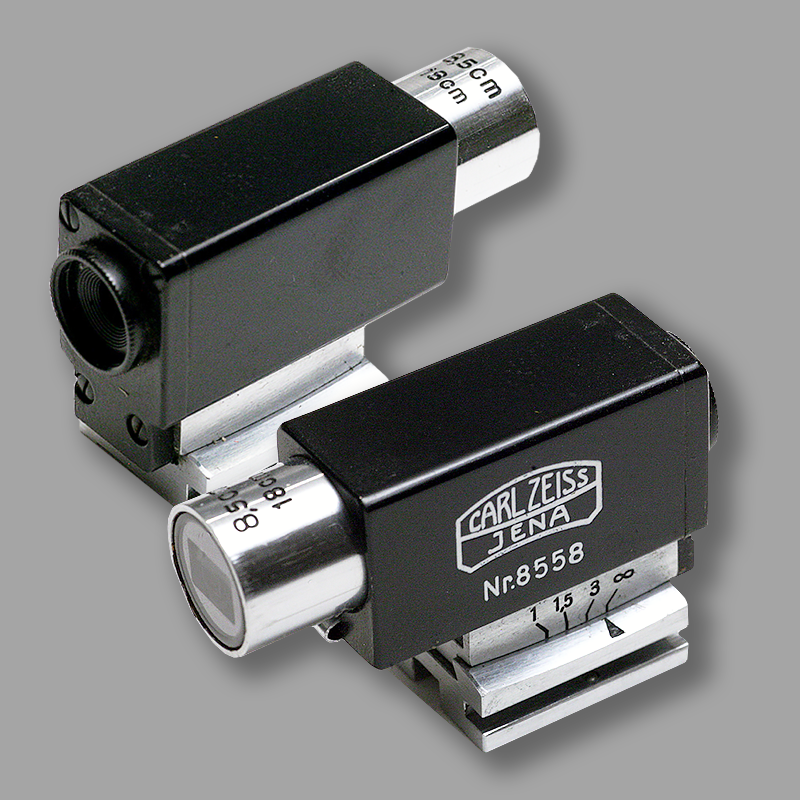
Zeiss Multi lens optical viewfinder model 436
Viewfinders for the Contax came in many shapes and styles over the years, designed for different applications. These finders were the most versatile, covering a number of lenses with the same finder. Before WWII, Zeiss offered a 436/1 which covered 50, 85, 135 and 180mm lenses with a reversable tube and a 436/4 for 28, 50, 85, 135 and 180mm lenses. Early examples lack click stops (a chrome or nickle sping bar on the side).
There was also a 436/7 which came with either a 28 or 35 wide lens, and 50, 85, 135 and 180mm coverage. Finally there was the 436/70 which covered 28, 35, 50, 85 and 135mm.
- Origin: Dresden, Germany
- Year: 1935
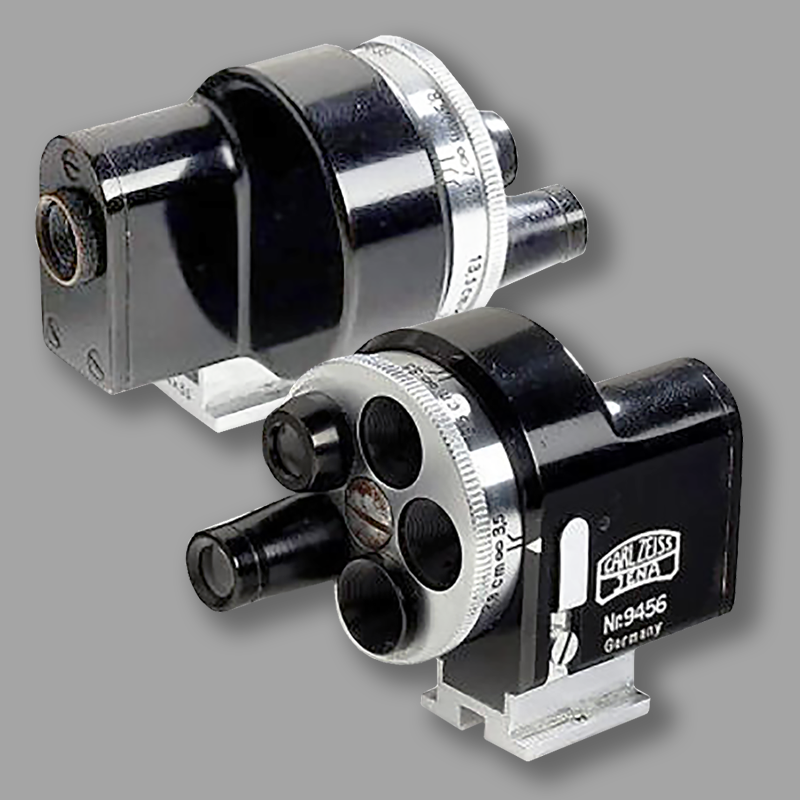
Zeiss Jena Universal Finder 436/7
The rotating turret universal finder is a legacy of Zeiss to the world of 35mm photography. It was not the first Zeiss finder with several fields of view. That was the ingenious, compact 436/1. But often a tube of a 436/1 was lost.
The revolving turret finder 436/4 was made to solve this problem. This Universal Finder was introduced with a five-position turret. The 436/7 was introduced a little later. Initially, it had the same optical assemblies as the 436/4, but a production change resulted in a second generation of the 436/7 with notably shorter projecting cones. All versions feature parallax correction marks which allow shifting the turret slightly to adjust for closer objects.
- Origin: Zeiss Ikon Jena, Germany
- Year: 1936
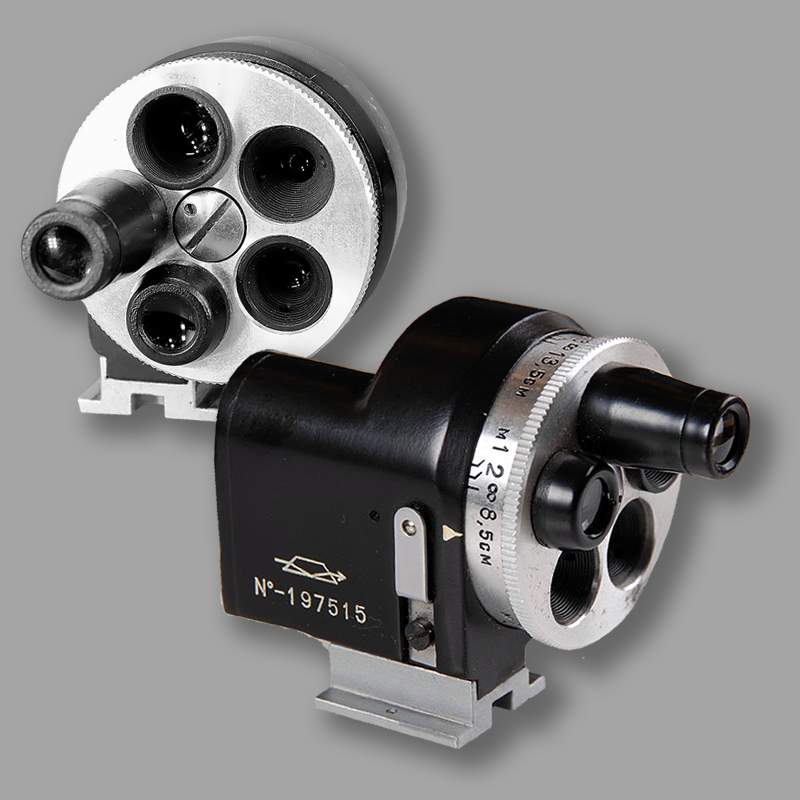
KMZ Rotating Optical Viewfinder
After WW II, the Soviets robbed a lot of Zeiss equipment. The USSR Arsenal company started building Contax clones named Kiev, together with KMZ, which copied Zeiss optics for the Kiev. They also copied the Zeiss Universal Viewfinder. KMZ started to manufacture them in 1948, and stopped ca. 1980.
So, this KMZ-turret viewfinder is a copy of the Zeiss universal viewfinder for the Contax. It can be mounted on any accessory shoe . The finder has five physically different focals namely 28, 35, 50, 85 and 135mm. The KMZ-Viewfinder has a simple parallax correction system. On the side of the viewfinder are 2 marks for every focal: one for infinity and one for 1 meter.
- Origin: Kiev, Ukraine
- Year: 1949
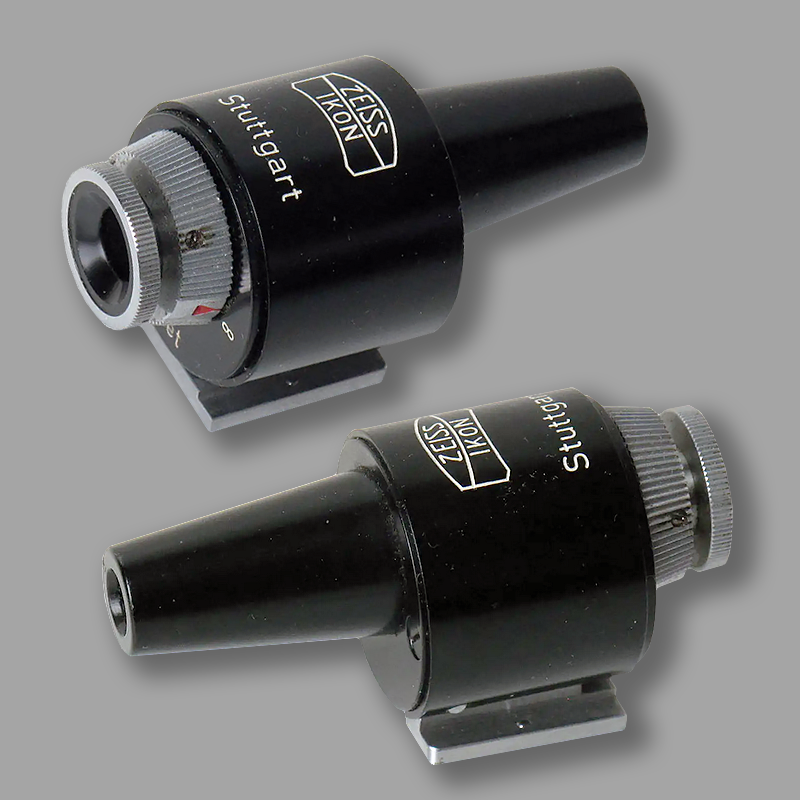
Zeiss Ikon Torpedo Finder 438
This Zeiss Ikon Torpedo tele finder 438 was made for 8.5 + 13.5cm lenses. It provides the 85mm field of view, but has framelines for the 135mm.
In the early Stuttgart version of the 438 finder, the fields of view were marked in centimeters, while millimeters belonged to Jena and later Stuttgart models. On the back surface, feet or meters appeared on early examples; both units. on later ones. The foot of the early Stuttgart issue was marked 438: later ones simply indicated Germany. In keeping with Jena’s practice, numbers identified everything they mark. Their Torpedoes had no model designations and came serially numbered, generally in the range of 20,000 to 27,000.
- Origin: Stuttgart, Germany
- Year: 1950
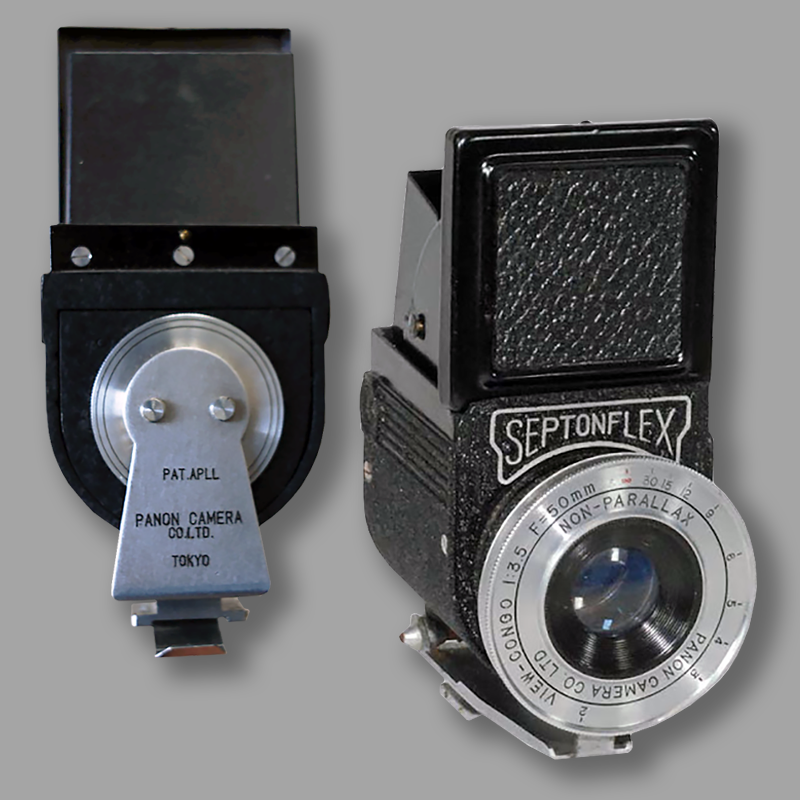
Septonflex
The Septonflex is an auxiliary reflex finder made in the mid-1950s by Panon Camera Shoko, for use on 35mm cameras. It is made of a mirror box, with a viewing hood and a View-Congo 50mm lens, perhaps supplied by Yamasaki. The name Septonflex is inscribed in front of the hood, above the lens. The whole device clips on the camera’s accessory shoe, and can rotate for horizontal and vertical pictures.
Six versions of the finder were offered in 1955, with f/2.8 or f/3.5 lens, at a price ranging from 2,700 to 4,850 yen. All examples are fitted with a View-Congo 50mm f/3.5 lens and automatic parallax correction.
- Origin: Panon, Japan
- Year: 1955
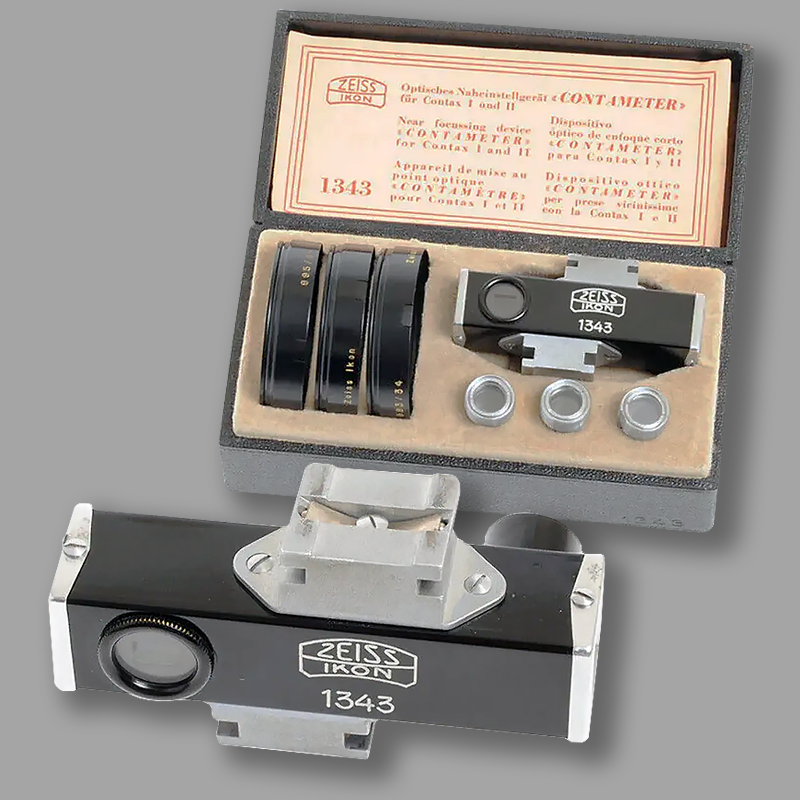
Zeiss Ikon Close-Up Set for Contax
Zeiss initially offered a close-up for the Contax I, which carried over for the Contax II. It was the Contameter 1343. It consisted of a rangefinder with a removable optic. There was an appropriate optic for each of the three close-up lenses which allowed a focusing range of 20”, 30” and 50″in the set. A similar set was made to take into account the difference in parallax on the Contax III, the shoe being raise further away from the lens by the exposure meter.
After the war, the Contameter for the Contax IIa was redesigned, with a wheel on the top with settings for each of the three supplied settings. A version was also produced for the Contax IIIa.
- Origin: Wetzlar, Germany
- Year: 1936
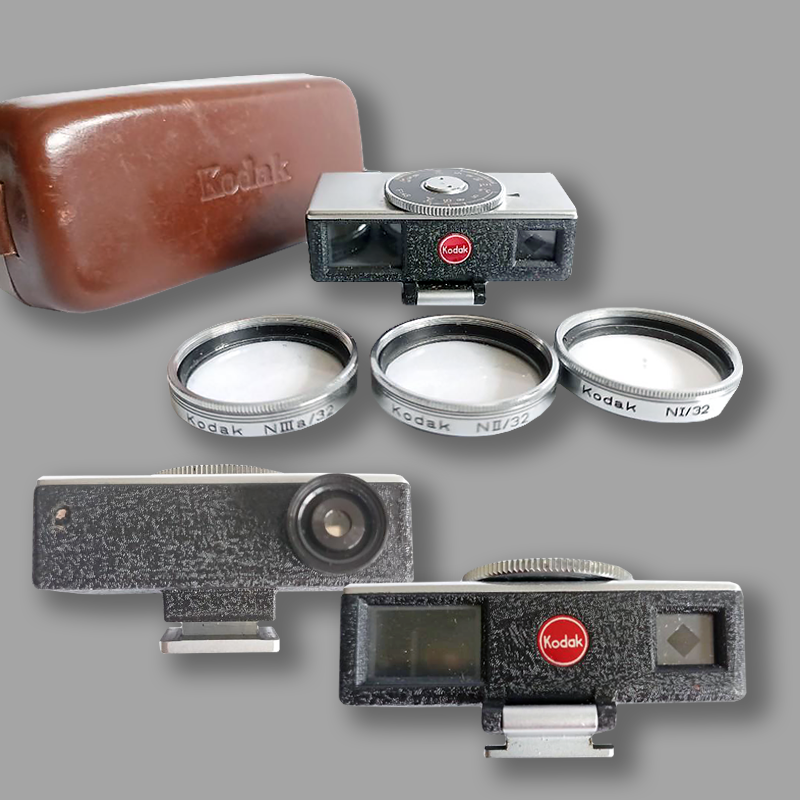
Kodak Retina close-range & viewfinder kit
The Retina IIc and IIIc did not have frame markers in their rangefinders for the 35 and 80mm lenses so Kodak manufactured this kit containing a close-range finder & 2 close-up lenses.
The Retina close-up rangefinder is an optical precision rangefinder showing also the exact field of view for close-ups with the Kodak NI and NII supplementary lenses. Automatic parallax compensation ensures that the finder view exactly corresponds to the image recorded on the film. Covers the distances from 38″ down to 11 1/2 inches. Two models are available: one for the Kodak Retina Ib, IIc and IIIc and one for the Kodak Retinette.
- Origin: Stuttgart, Germany
- Year: 19??
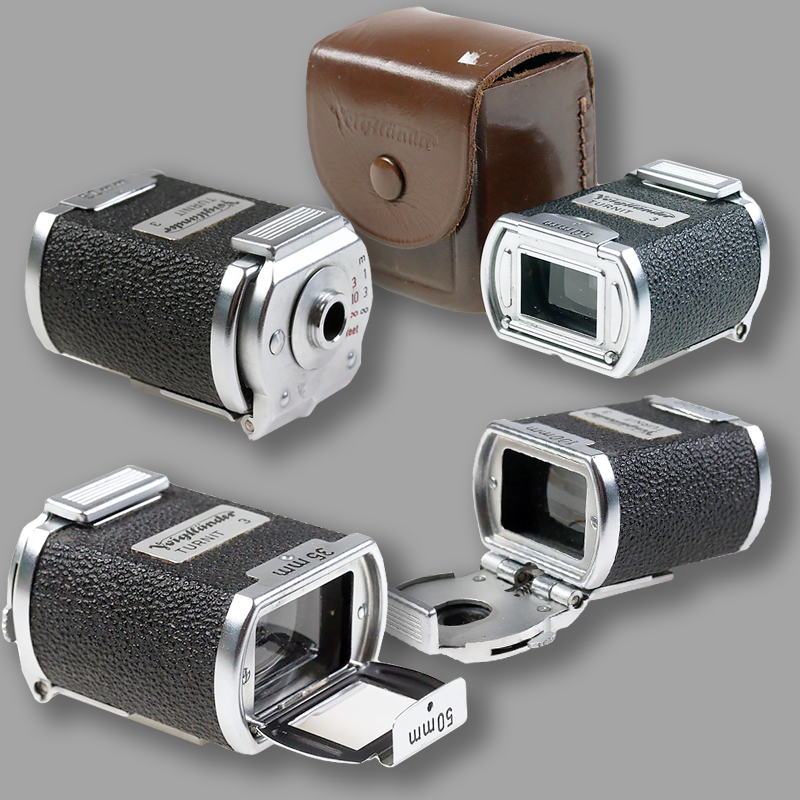
Voigtländer Turnit from 1956
This Turnit-viewfinder was designed for the different focal lengths of the Voigtländer Prominent camera. Available versions:
– 1954: Bakelite viewfinder for focal lengths 35 and 100 mm;
– 1955: Leather-covered for focal lengths 35 and 100 mm;
– 1956: Turnit-3 viewfinder for focal lengths 35, 50 and 100 mm.
The Turnit 3 viewfinder from 1956 also had a folding mask for the 50 mm normal lens. By simply turning the mounting slide, the Turnit could be used as a viewfinder for either the 35mm or 100mm lens. For the 150 mm lens there was a pre-mask that reduced the viewfinder image for this lens.
- Origin: Braunschweig, Germany
- Year: 1956
The flynngraphics.ca website covered a large number of Canon viewfinders. Below are six viewfinders that are more than worth mentioning separately.
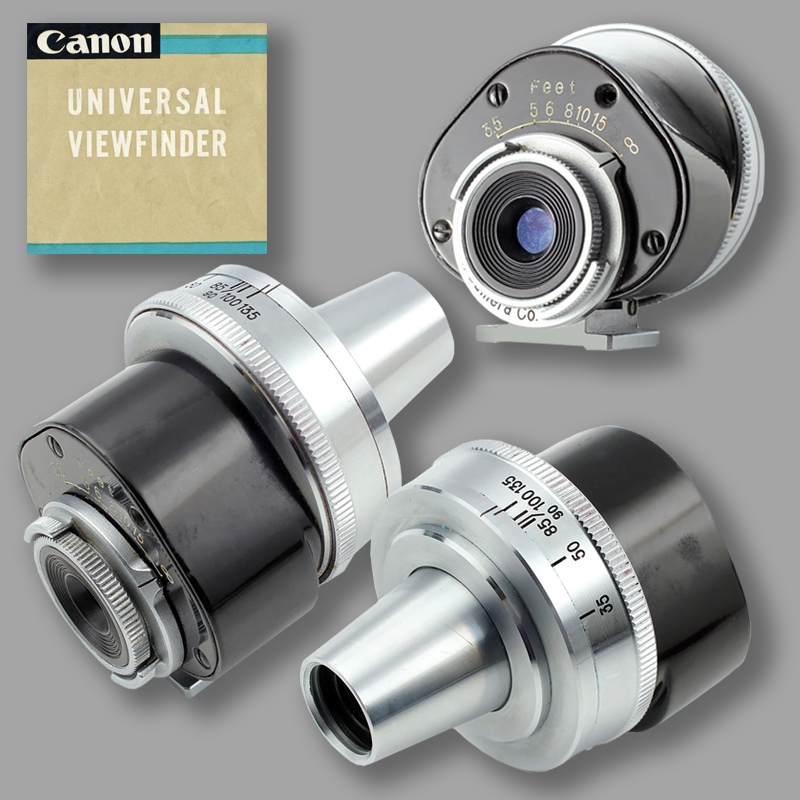
Canon Universal Viewfinder
The Canon Universal Viewfinder of 1952 is a precision instrument through which an exceptionally sharp and erect image can be viewed. Field of view is variable for lenses with focal length of 35mm to 135mm.
With an 28mm Front Attachment, this may also be used with Canon’s 28mm extra-wide angle lens. Click stops offer positive setting at any particular focal length marking. A parallax compensating scale, calibrated in feet, enables accurate parallax correction.
The Jardine catalogue from about 1952 refers to a 28mm attachment that extends the range of the Universal Viewfinder to 28mm lenses. Actually, the Viewfinder lens is threaded to accept this add-on which actually looks pretty strange when it is mounted.
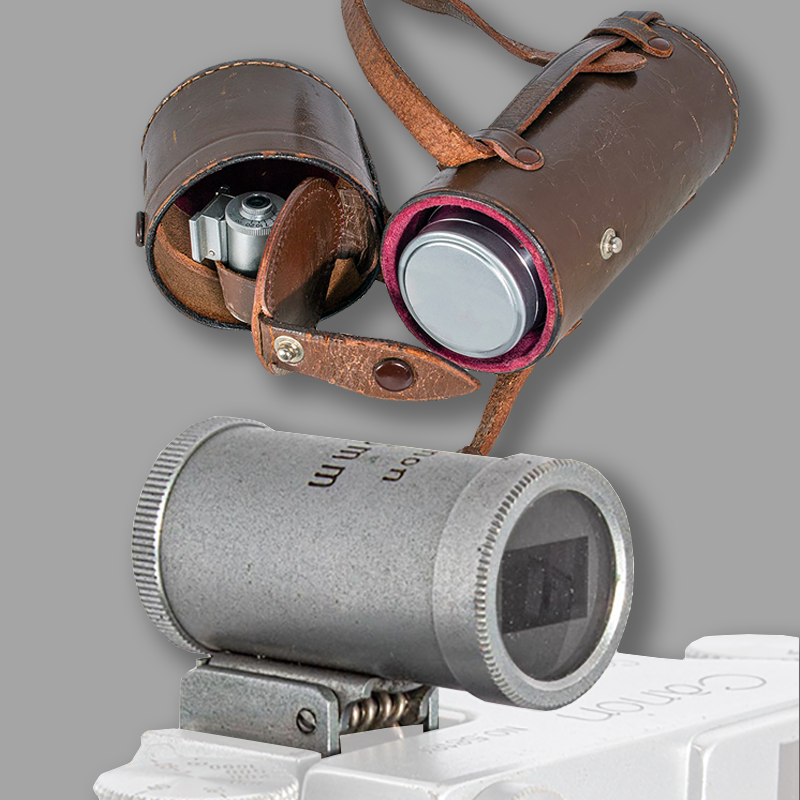
Canon Special Viewfinder 1955
Possibly the most common viewfinder is the ‘Special Viewfinder’ which seems a poor name for such a workhorse. Prior to the introduction of the Model VT in 1956 these little viewfinders were sold separately or together with the various Canon lenses except for the 50mm lenses which did not require it. The camera bodies all had 50mm viewfinders. These special view finders accurately defined the field-of-view, and corrected parallax. Mounted on the accessory shoe of the camera.
They were available for the 28mm, 35mm, 85mm, 100mm and 135mm lenses. When they were sold together with the lenses they were contained in a small compartment in the top of the leather lens case so that they could be stored and transported together and not get mixed with the wrong lens.
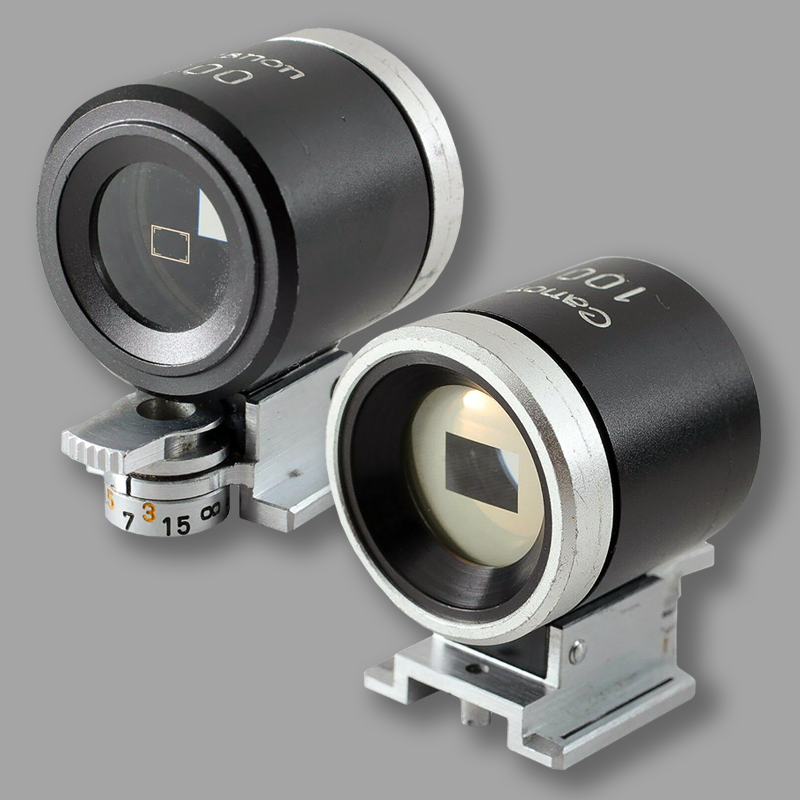
Canon Lumi-Field Viewfinder
The Lumi-Field Viewfinder gives a clear, sharp field-of-view by a brilliant white-line frame, while at the same time permitting observation of an outer margin which will not appear in the photograph. They were made for the 50mm, 85mm, 100mm,and 135mm lenses.
The Viewfinder couples to the built-in rangefinder mechanism of the Canon Camera VT de luxe camera for automatic parallax compensation. Distance was given in both feet and meters.
The front element is silvered on the back except for the rectangle throuh which the scene is viewed. The frame lines are imprinted on the inside of the rear lens. In the shoe mount on the right edge is the domed pin that fits on top of the camera’s parallax correction pin.
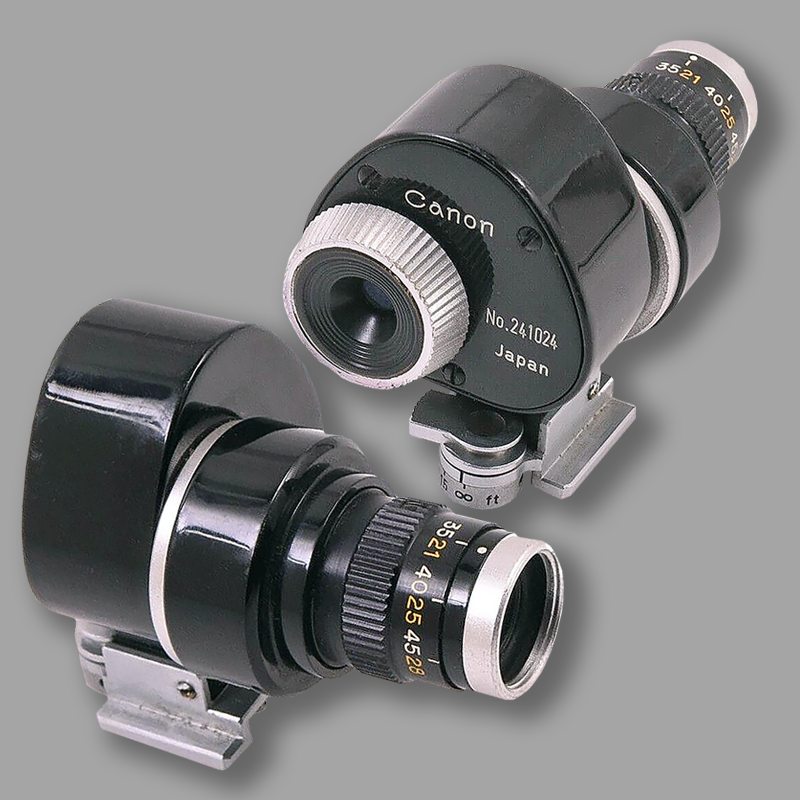
Canon Universal Zoomfinder
The Universal Zoomfinder gives the actual field of view and correct magnification for focal lengths between 35mm and 135mm. The view of the image expanded and contracted and the frame was constant because the viewfinder lens was a true zoom lens. The earliest reference is in the 1956 ‘Canon System of Photography’ leaflet.
There were actually 2 viewfinders; the Long Focus Model ‘L’ for 135mm to 85mm and the Short Focus Model ‘S’ for 35 to 55mm. For the Zoomfinder S was a front attachments available that changed the range to 2lmm to 28mm focal length. The Zoomfinders had its own built-in automatic parallax compensation. Distance was set on the scale by moving the lever at the back of the shoe mount. The eyepiece was adjustable for individual eye-sight.
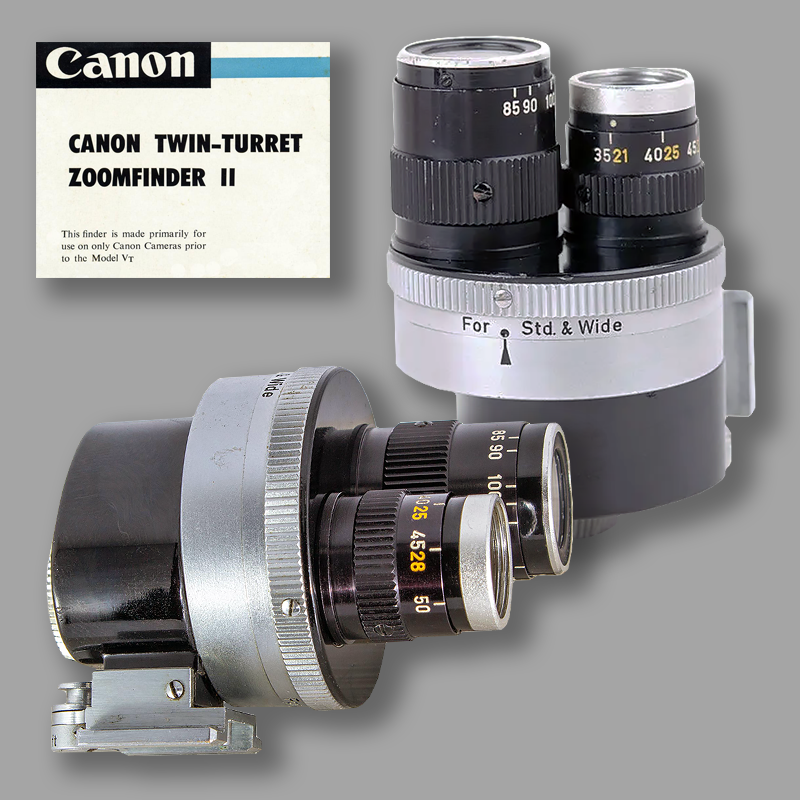
Canon Twin-Turret Zoomfinder
The problem with the Zoomfinder was the fact that one had to have two of them to cover the whole range of focal lengths from 21mm to 135mm. The obvious solution was to combine the two lens ranges into one rotating turret viewfinder. The result was the Twin-Turret Zoomfinder.
There were apparently two versions of the Twin-Turret Viewfinder, the original one and the Twin-Turret Zoomfinder II. The Zoomfinder I, has no built-in parallax correction and relies on the internal parallax correction of the later, post VT model, rangefinders. The II version had its own built in parallax correction. The files of view are extremely brilliant because this finder has a “real-image” optical system and incorporates two separate optical zoom systems for wide-angle and telelenses.
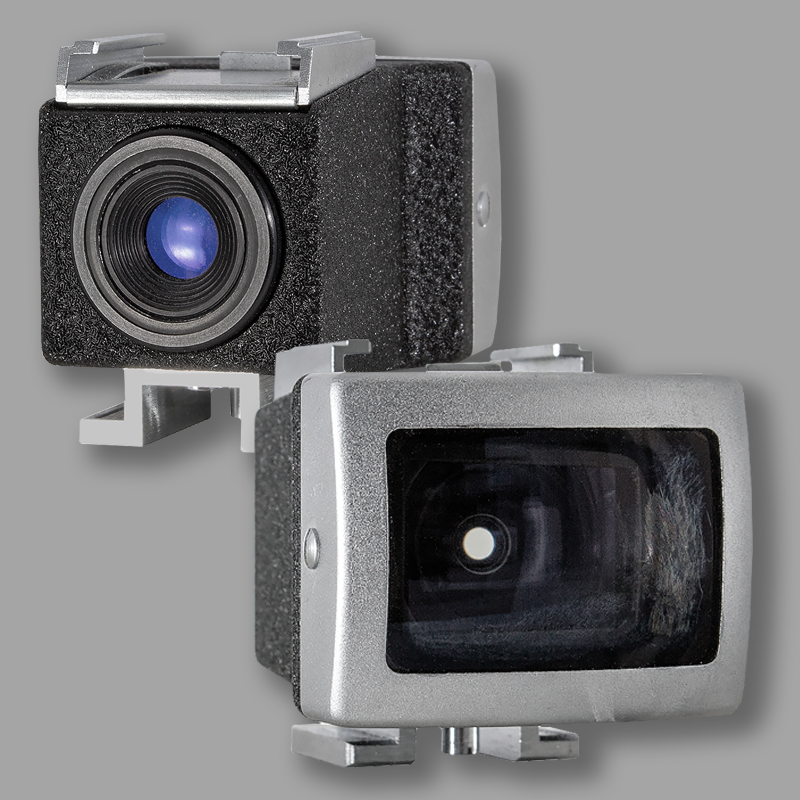
Canon 19mm Special Viewfinder
There is a viewfinder that does not fit in any anywhere of the categories. There may be others but this was made for the FL 19mm f/3.5 lens. The viewfinder was sold together with the FL 19mm lens. It was packaged with the lens in a black leather velvet lined case in its own separate compartment.
The uniqueness of this viewfinder becomes clear when examined closely. Firstly, there is no parallax correction ability in the viewfinder. The mounting foot is firmly attached to the body of the viewfinder and is not pivoted so it cannot tilt. When it is mounted in the camera shoe it is immovable. And of course the SLR cameras have no need of it so they are built without separate means of parallax correction. That means that this viewfinder does not fall into any category as discussed before.

